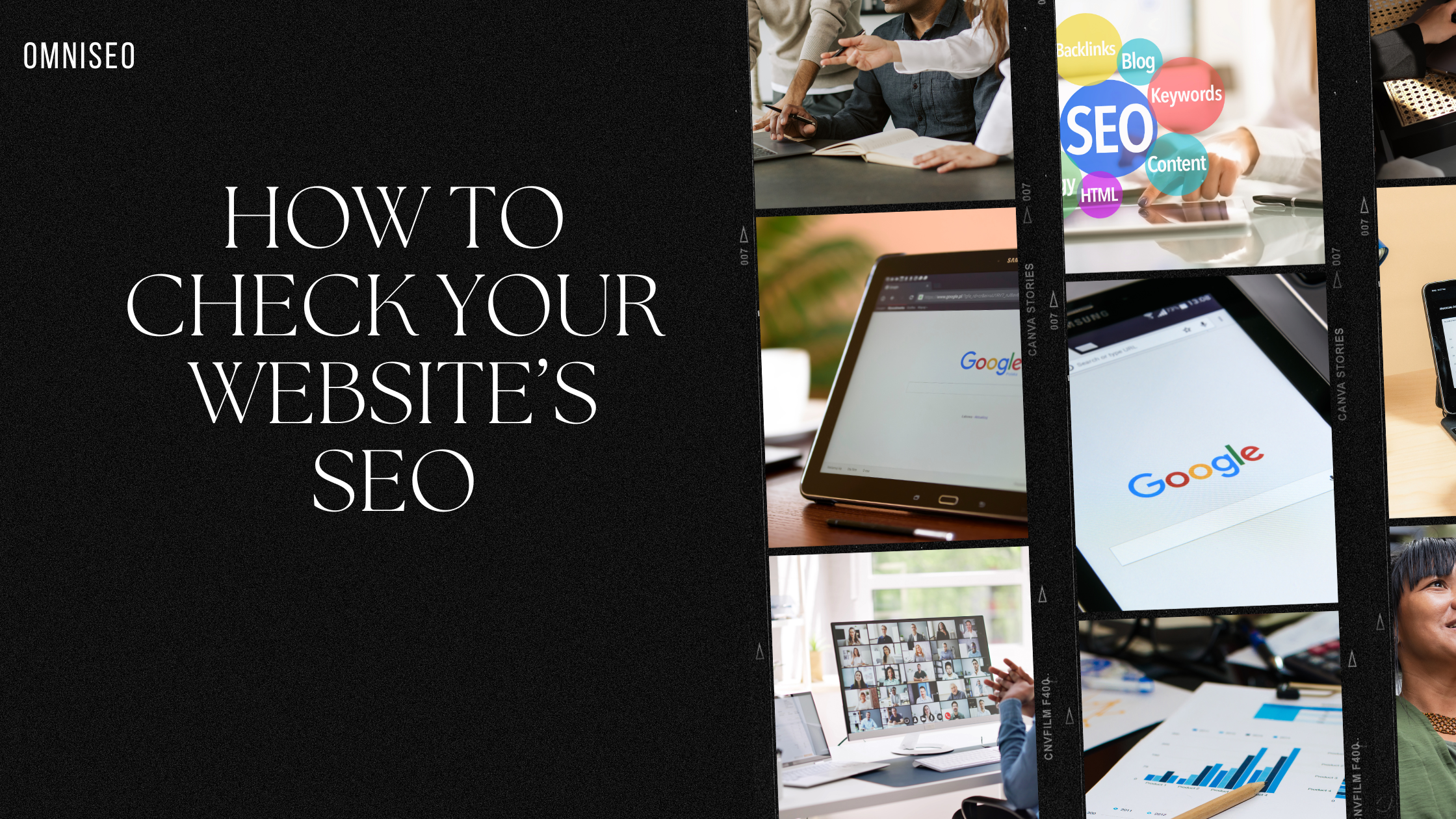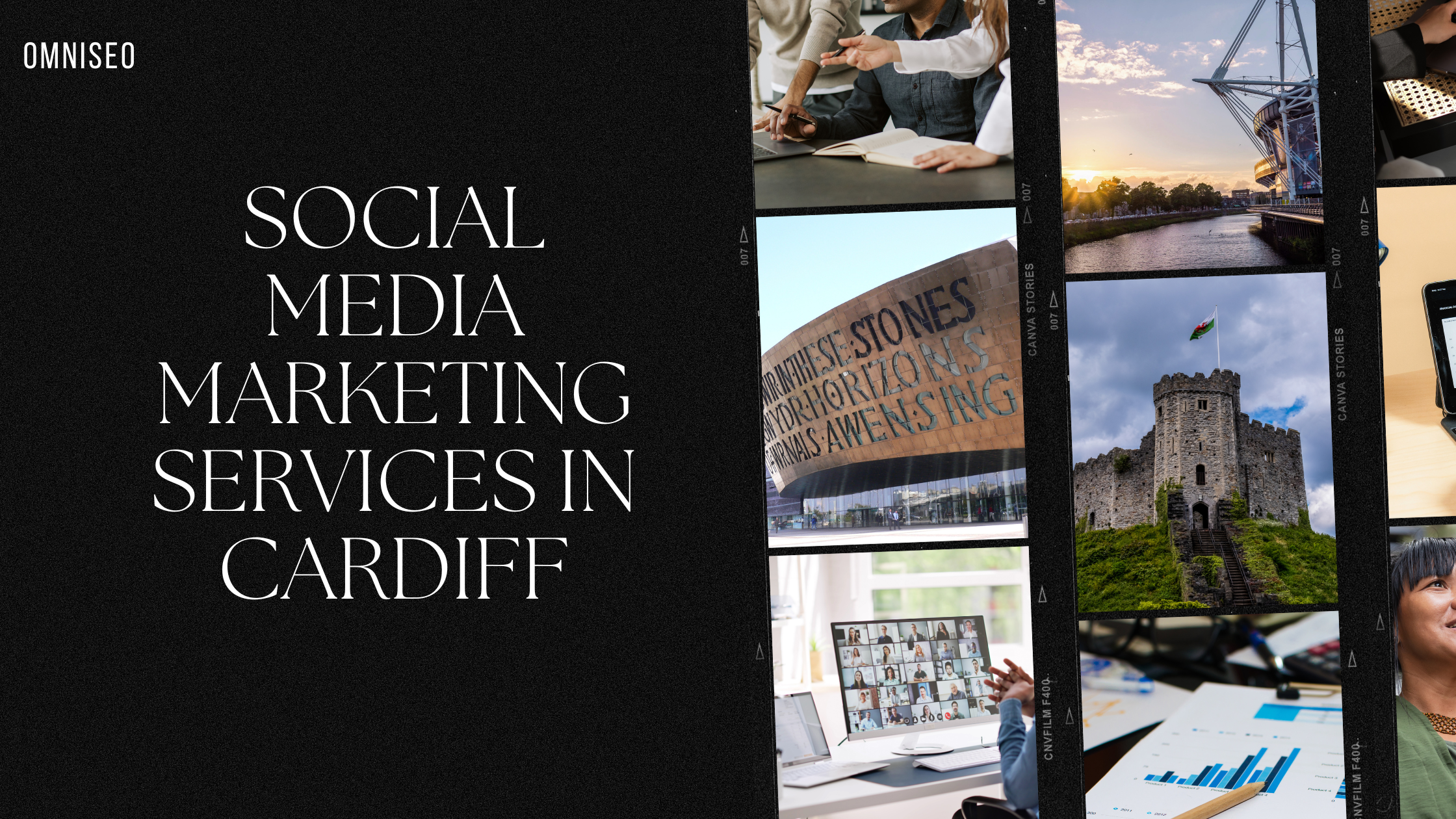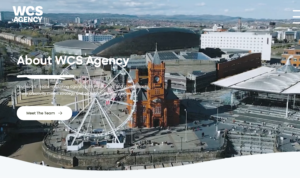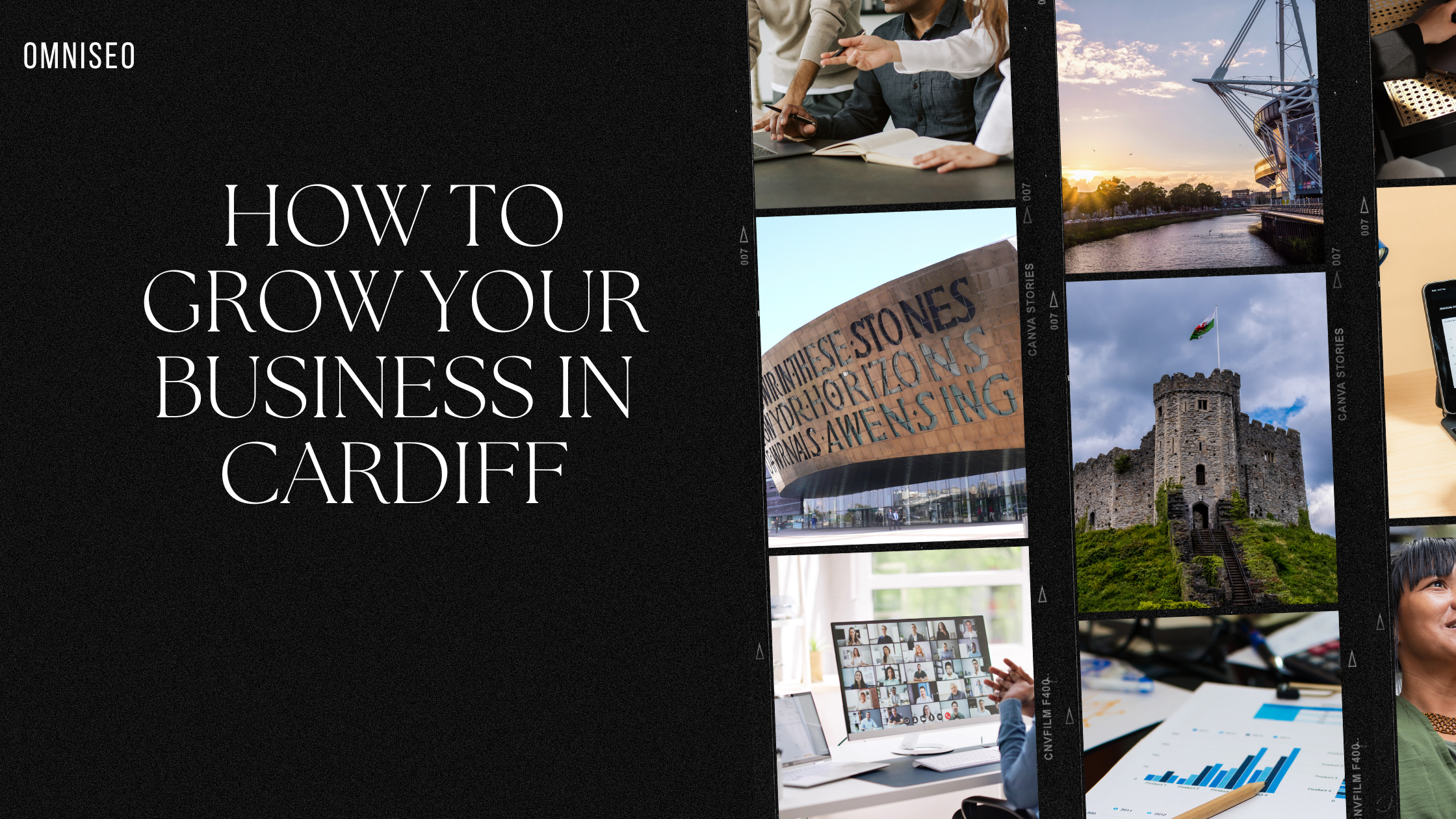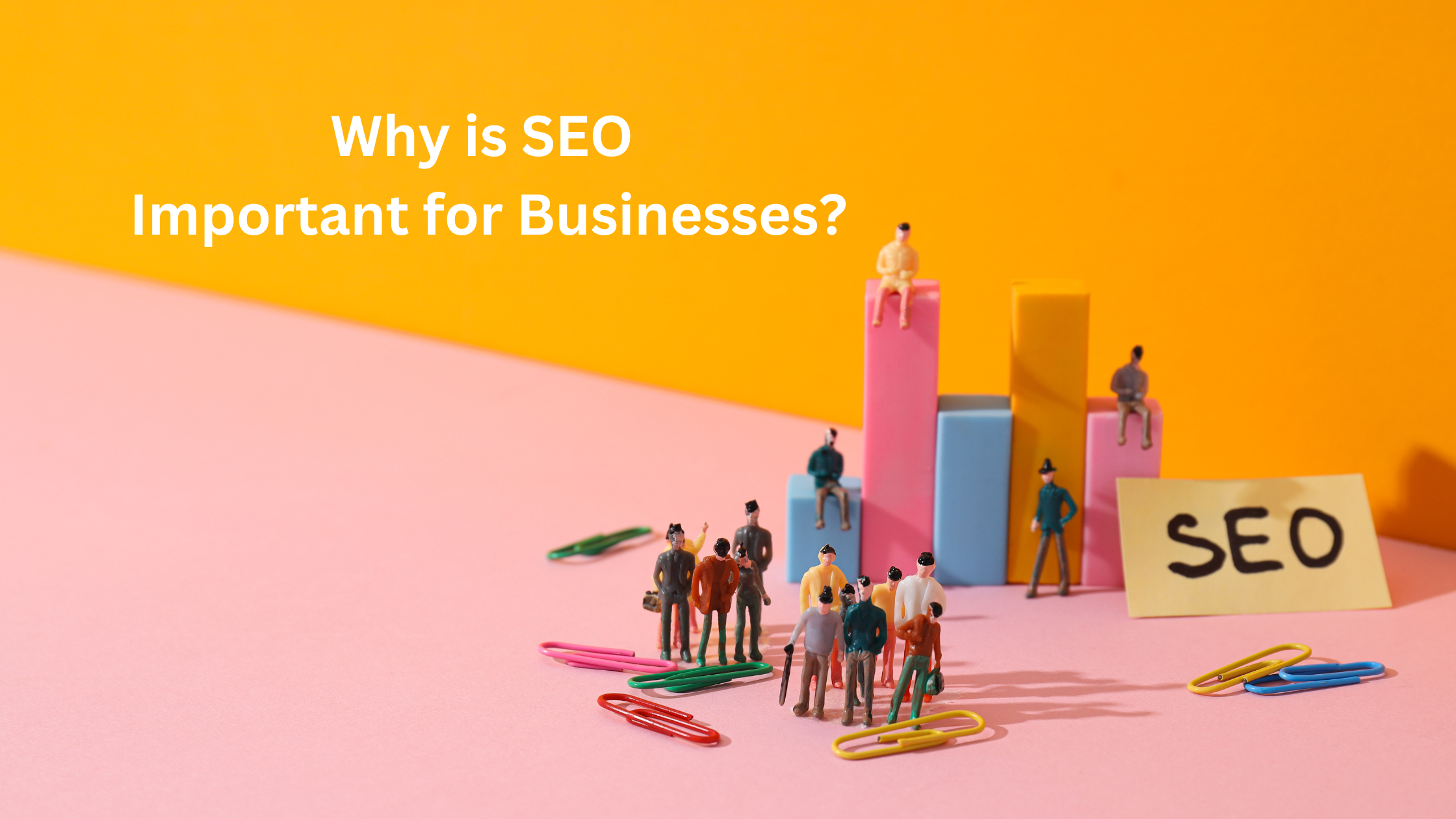How to Check Website SEO: A Simple Guide for Website Owners
How to Check Website SEO: A Comprehensive Guide for Website Owners
In today’s digital age, having a website is not enough. To stand out and attract the right audience, your website needs to be optimised for search engines.
Search Engine Optimisation (SEO) is a crucial aspect of digital marketing that ensures your website ranks higher in search engine results pages (SERPs), making it easier for users to find you.
But how do you know if your website is performing well from an SEO standpoint? Today we’ll explore various ways you can check your website’s SEO health, review the best tools for the job, and maybe even provide a few sneaky tips you won't find anywhere else.
But first, let's start with why this matters at all:
Why SEO Matters
Before we dive into how to check your website's SEO, it's important to understand why SEO matters in the first place. SEO is the process of improving your website's visibility in search engines like Google, Bing, and Yahoo. The higher your website ranks on the search engine results pages (SERPs), the more likely people are to visit it. SEO involves multiple factors, including the quality of your content, website structure, backlinks, keywords, mobile-friendliness, and site speed.
If you neglect SEO, your website might struggle to show up in search results, leading to lower organic traffic and fewer opportunities for conversions. Regularly checking and improving your website's SEO ensures you're reaching the right audience and achieving your business goals.
What to Check for When Reviewing Your Website’s SEO
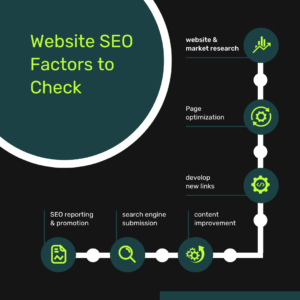
When evaluating your website’s SEO, several factors come into play. These are the elements search engines prioritise when ranking websites. Let’s break down the key SEO elements you should regularly review:
On-Page SEO
On-page SEO refers to the aspects of your website that you can control directly. This includes:
-
Title Tags and Meta Descriptions: Title tags are HTML elements that specify the title of a web page. A well-written title tag helps search engines understand the content of your page. Similarly, meta descriptions provide brief summaries of page content, helping users decide whether to click on your page in search results.
-
Headings and Subheadings: Headings (H1, H2, etc.) help break up content and make it more readable. They also allow search engines to understand the structure of your content.
-
Content Quality: Your content should be relevant, informative, and optimised for the keywords that users are likely searching for. Make sure your content addresses user intent and provides real value.
-
Internal Linking: Linking to other pages on your website helps users navigate your site and improves the flow of link equity throughout your site, boosting your SEO.
-
Keyword Usage: Effective keyword usage is essential for on-page optimisation. Keywords should be naturally integrated into the content, headers, and meta tags.
-
Image Optimisation: Use descriptive file names and alt text for images to ensure search engines can interpret them correctly. Optimised images can also improve page load speed.
Off-Page SEO
Off-page SEO involves activities done outside of your website to improve its ranking. The key factor here is backlinks, which are links from other websites that direct users to your site. High-quality backlinks signal to search engines that your website is trustworthy and authoritative. You should regularly assess your backlink profile using tools like Google Search Console or Ahrefs.
Technical SEO
Technical SEO refers to the behind-the-scenes factors that affect how search engines crawl and index your website. Some of the most important technical SEO elements to check include:
-
Mobile Friendliness: With the rise of mobile devices, Google uses mobile-first indexing, meaning the mobile version of your site is prioritised for ranking purposes. Use Google’s Mobile-Friendly Test to see how well your site performs on mobile devices.
-
Page Speed: A slow-loading website can lead to higher bounce rates and lower rankings. Use tools like Google PageSpeed Insights to assess how fast your website loads and get recommendations for improvement.
-
URL Structure: URLs should be short, descriptive, and contain relevant keywords. Avoid long, complex URLs with unnecessary characters.
-
Sitemap and Robots.txt: A sitemap helps search engines crawl and index your website effectively, while a robots.txt file instructs search engines on which pages they can or cannot crawl.
-
SSL Certificate: Websites with HTTPS encryption are considered more secure and are given priority by search engines. Ensure your website has an SSL certificate to improve both security and SEO.
-
Structured Data Markup: Adding structured data (also known as schema markup) helps search engines better understand the content on your website, which can improve your visibility in rich snippets and featured results.
User Experience (UX)
User experience (UX) is increasingly becoming a ranking factor in SEO. Google wants to prioritise websites that offer a positive user experience, which includes:
-
Navigation and Structure: A well-organised website with clear navigation helps users find what they’re looking for quickly.
-
Bounce Rate and Time on Site: High bounce rates or low time on site might indicate that users aren't finding your content useful. This can negatively impact your SEO.
-
Engagement: Encourage users to engage with your content by using call-to-actions (CTAs), multimedia, and compelling content that holds their attention.
The Best SEO Tools to Check Your Website’s SEO
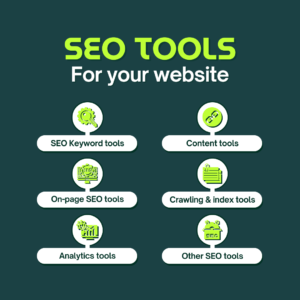
Checking your website’s SEO manually can be time-consuming and complex. Thankfully, there are a number of tools available that can help you streamline the process. Here are some of the best SEO tools for analysing your website:
Google Search Console
Google Search Console is a must-have tool for website owners. It provides invaluable data on how your website is performing in Google search, including impressions, clicks, and average position. It also helps you track indexing issues, crawl errors, and backlink performance. By regularly reviewing your Google Search Console account, you can stay on top of technical SEO problems and address them promptly.
Google Analytics
Google Analytics is another essential tool for measuring website performance. While it doesn't provide direct SEO insights, it gives you an overview of user behaviour, including traffic sources, bounce rates, and conversion rates. This information is crucial for evaluating how your SEO efforts are impacting user engagement and conversions.
SEMrush
SEMrush is a comprehensive SEO tool that provides insights into your website’s SEO performance, keyword rankings, backlink profile, and more. It also offers competitive analysis, allowing you to track how your website compares to competitors in your niche. SEMrush’s Site Audit tool is particularly useful for identifying on-page and technical SEO issues.
Ahrefs
Ahrefs is widely regarded as one of the most powerful SEO tools on the market. It offers an in-depth backlink analysis, keyword research, content analysis, and competitor research. The Site Audit feature can help identify technical issues, while the Rank Tracker allows you to monitor your keyword rankings over time.
Yoast SEO (For WordPress Sites)
If you're using WordPress, the Yoast SEO plugin is a must-have. It helps optimise your on-page SEO by providing real-time analysis of your content, meta descriptions, and keyword usage. Yoast also generates an XML sitemap and integrates with Google Search Console for easier site management.
Moz Pro
Moz Pro is another great tool for tracking your website's SEO performance. It offers a range of features, including keyword tracking, site audits, and backlink analysis. The MozBar, a browser extension, allows you to quickly view important SEO metrics on any webpage.
Screaming Frog
Screaming Frog is a website crawler that can help you identify technical SEO issues on your website, such as broken links, missing meta descriptions, duplicate content, and more. It's particularly useful for large websites with hundreds or thousands of pages.
How OmniSEO Can Help Your Website Rank Higher
While checking your website’s SEO is an essential step in improving its performance, SEO can be a complex and time-consuming process. That’s where omniSEO, one of the leading SEO agencies in Cardiff, can help. With years of experience helping businesses achieve significant SEO results, omniSEO has built a reputation for delivering tailored SEO strategies that drive real, measurable results.
Whether you're a local business in Cardiff or a national or global brand, omniSEO's team of experts can analyse your website’s SEO health, identify areas for improvement, and implement strategies that will boost your rankings, drive more traffic, and increase conversions.
OmniSEO Offers a Free SEO Game Plan
If you’re unsure where to start or how to improve your website’s SEO, omniSEO offers a free SEO game plan to help you get started. This plan includes a one-on-one phone call with an SEO professional who will review your website, provide valuable feedback, and offer actionable tips to help you quickly boost your website's rankings and traffic. If you're looking to improve your website's SEO but aren't sure where to start and are looking to avoid investing more than necessary, this is the best way to start. Whether you're looking for quick wins or long-term strategies, omniSEO’s team is here to help.
Checking your website’s SEO is a crucial step in improving its visibility, driving more traffic, and ultimately achieving your business goals. By regularly assessing on-page, off-page, and technical SEO factors, and using the right tools, you can ensure that your website is performing at its best.
However, SEO can be complex, and for many businesses, it’s a task best left to the experts. OmniSEO, one of Cardiff's top SEO agencies, has a proven track record of delivering exceptional results for both local and national clients. With a free SEO game plan, you can get professional advice on how to quickly improve your website’s SEO performance.
So, why wait? Start checking your website’s SEO today and take the first step toward achieving better rankings and more traffic!
Best Social Media Marketing Services for Businesses in Cardiff
Best Social Media Marketing Services for Businesses in Cardiff
In today’s digital-first world, social media has become a cornerstone of business success. For businesses in Cardiff and its surrounding areas, leveraging the power of platforms like Facebook, Instagram, LinkedIn, and TikTok isn’t just an option—it’s step 1 of being seen.
With a vibrant local economy, a growing tech scene, and a population eager to engage online, Cardiff offers a fertile ground for businesses to amplify their presence through social media marketing (SMM). But with so many agencies and services available, how do you choose the best ones to suit your needs?
As Cardiff’s leading SEO agency, we have more experience with this than most. And today, we’re answering the question for you. We’ll explore what makes these services stand out, the specific offerings you can expect, and why partnering with a local expert can give your business the edge it needs. Whether you’re a small startup in Cathays or an established firm in Pontypridd, this guide will help you navigate the SMM landscape and find the right fit.
But first, a little more on why:
Why Social Media Marketing Matters for Cardiff Businesses
Before we dive into the best services, let’s establish why SMM is critical for businesses in Cardiff. The Welsh capital is a bustling hub with a population of over 360,000, a thriving university community, and a strong SME (small and medium enterprise) sector that employs nearly 63% of the workforce. Add to that its proximity to areas like Newport, Barry, and the Valleys, and you’ve got a diverse, digitally-savvy audience waiting to connect with brands.
Social media offers unparalleled opportunities to:
- Boost Brand Visibility: Platforms allow businesses to reach local and regional audiences with targeted content.
- Engage Customers: From responding to comments to running polls, SMM fosters two-way communication.
- Drive Conversions: With the right strategy, likes and follows can turn into sales and loyal customers.
- Stay Competitive: Cardiff’s competitive market means businesses need to stand out—SMM is a cost-effective way to do that.
With this in mind, let’s break down the best SMM services available in Cardiff and the surrounding areas, focusing on agencies and offerings that deliver real results.
Top Social Media Marketing Services in Cardiff
1. WCS Agency
Location: Cardiff
Why They Stand Out: WCS Agency is a female-founded, social-first marketing firm that blends creativity with strategy. They emphasise measurable results over vanity metrics like likes, focusing instead on engagement, lead generation, and ROI.
Key Services:
- Paid Social Ads: Targeted campaigns on platforms like Facebook, Instagram, and LinkedIn to drive traffic and conversions.
- Organic Social Strategy: Content planning and community management to build a loyal following.
- Content Creation: High-quality visuals and copy tailored to your brand’s voice.
- Influencer Management: Connecting businesses with local influencers to expand reach.
Best For: Businesses looking for a strategic partner that acts as an extension of their team. WCS has worked with prestigious clients like NHS Wales and Principality Building Society, proving their ability to handle diverse industries.
Local Advantage: Their deep understanding of Cardiff’s culture and audience preferences ensures campaigns resonate locally.

2. Thrive Internet Marketing Agency
Location: Cardiff (with broader UK reach)
Why They Stand Out: Thrive brings a data-driven, conversion-focused approach to SMM. They’re known for crafting bespoke campaigns that align with specific business goals, whether it’s brand awareness or sales growth.
Key Services:
- Social Media Management: Full oversight of your accounts, including posting schedules and analytics.
- Ad Campaigns: Precision-targeted ads using the latest trends and audience data.
- Content Development: Engaging, on-brand posts that attract and retain followers.
- Reputation Management: Monitoring and enhancing your online presence.
Best For: Companies needing a comprehensive digital marketing partner beyond just social media (they also offer SEO and PPC). Their experience with Cardiff’s competitive landscape makes them ideal for businesses aiming to outshine rivals.
Local Advantage: They tap into Cardiff’s economic strengths—like its fintech and education sectors—to tailor campaigns effectively.
3. Red Rag Marketing
Location: Cardiff (with services in nearby cities like Newport)
Why They Stand Out: Red Rag specialises in lead generation and brand awareness through strategic social media campaigns. They’re particularly adept at Facebook marketing, leveraging its vast user base to target Cardiff residents.
Key Services:
- Facebook Advertising: Highly targeted campaigns to boost engagement and sales.
- Social Media Training: Empowering businesses to manage their own accounts with expert guidance.
- Content Strategy: Crafting posts that resonate with your audience and drive action.
- Analytics Tracking: Detailed reporting to measure campaign success.
Best For: Small businesses or startups in Cardiff wanting quick, tangible results without a massive budget. Their hands-on approach and proven track record make them a go-to choice.
Local Advantage: They understand Cardiff’s urban dynamics and use this to target the right demographics effectively.
4. Ripple Marketing
Location: Cardiff
Why They Stand Out: A boutique agency founded by marketing enthusiasts, Ripple focuses on bespoke strategies and hands-on implementation. They excel at turning social media into a dynamic growth tool for local businesses.
Key Services:
- Content Creation: From blog posts to Instagram reels, they produce compelling material.
- Community Management: Building and nurturing your online audience.
- Social Advertising: Targeted ads to boost lead generation and conversions.
- Analytics: Data-driven insights to optimise performance.
Best For: Businesses seeking a personalised, collaborative approach. Ripple’s small size allows them to offer tailored attention, making them perfect for SMEs in Cardiff and nearby areas like Penarth.
Local Advantage: Their Cardiff roots give them insight into the local market, ensuring content speaks to Welsh audiences.
5. Burning Red
Location: Cardiff
Why They Stand Out: Known for innovative strategies and a content-first philosophy, Burning Red has worked with high-profile clients like the Welsh Government and Cardiff University. They prioritise authentic, engaging content over generic posts.
Key Services:
- Video Marketing: High-impact videos for platforms like YouTube and TikTok.
- Paid Social Promotion: Intensive ad campaigns across multiple channels.
- Organic Content: Strategic planning to grow your following naturally.
- Digital Strategy: Integrating SMM with broader marketing goals.
Best For: Larger businesses or organisations in Cardiff needing creative, high-quality campaigns. Their ability to handle complex projects sets them apart.
Local Advantage: Their work with local institutions shows a knack for appealing to Cardiff’s diverse community.
Key Features of Top SMM Services
When evaluating SMM services in Cardiff, certain features consistently define the best providers. Here’s what to look for:
- Tailored Strategies
The best agencies don’t use one-size-fits-all plans. They analyze your business, industry, and goals to create a custom approach. For example, WCS Agency and Thrive excel at aligning campaigns with specific objectives. - Content Creation Expertise
Engaging content is the backbone of SMM. Agencies like Ripple Marketing and Burning Red offer top-tier production, from eye-catching visuals to compelling copy that reflects your brand. - Paid and Organic Balance
Combining paid ads with organic growth maximises reach and ROI. Red Rag Marketing’s focus on Facebook ads paired with organic strategies is a prime example of this dual approach. - Local Knowledge
Cardiff’s unique blend of urban energy, Welsh culture, and student population requires a nuanced touch. Local agencies like WCS and Ripple leverage this understanding to craft relevant campaigns. - Analytics and Reporting
Measurable results matter. Top services provide detailed insights into engagement, conversions, and ROI, ensuring you know exactly what’s working.
Benefits of Choosing Local Cardiff SMM Services
Opting for a Cardiff-based SMM service offers distinct advantages:
- Cultural Relevance: Agencies familiar with Cardiff’s vibe—think its love for rugby, local events like the Cardiff Bay Food Festival, or the student-heavy areas—can create content that hits home.
- Proximity: Face-to-face meetings (when needed) are easier, fostering stronger collaboration.
- Economic Insight: Local experts understand Cardiff’s commercial landscape, from its financial services hub to its growing creative industries.
- Community Ties: Many agencies have connections with local influencers, businesses, and media, amplifying your reach.
For businesses in surrounding areas like Newport, Bridgend, or the Valleys, these agencies often extend their services, adapting strategies to suit regional nuances.
How to Choose the Right SMM Service for Your Business
With so many excellent options, picking the right service depends on your needs. Here’s a step-by-step guide:
- Define Your Goals
Are you aiming for brand awareness, lead generation, or direct sales? Agencies like Red Rag Marketing shine for leads, while Burning Red excels at awareness. - Consider Your Budget
SMM services vary in cost. Smaller agencies like Ripple offer affordability, while larger ones like Thrive may suit bigger budgets with broader needs. - Evaluate Expertise
Look at case studies or client testimonials. WCS Agency’s work with NHS Wales or Thrive’s track record with conversions can indicate capability. - Check Local Fit
If you’re in Barry or Pontypridd, ensure the agency understands your area’s audience. Most Cardiff-based firms are flexible enough to cover the region. - Ask About Reporting
Transparency is key. Confirm the agency provides regular updates—like Ripple’s data-driven analytics—to track progress.
Spotlight on Surrounding Areas
While Cardiff is the epicenter, businesses in nearby locales can also benefit from these services:
- Newport: Red Rag Marketing’s regional reach makes it a solid choice for Newport’s growing business scene.
- Penarth: Ripple Marketing’s personalised approach suits Penarth’s boutique businesses and affluent residents.
- Bridgend: Thrive’s comprehensive services can support Bridgend’s mix of retail and industrial firms.
- Valleys: WCS Agency’s ability to connect with diverse audiences works well for the Valleys’ tight-knit communities.
Many Cardiff agencies happily extend their expertise outward, adapting strategies to fit each area’s unique character.
Emerging Trends in Cardiff SMM
To stay ahead, the best SMM services in Cardiff are embracing these trends:
- Short-Form Video: TikTok and Instagram Reels are booming—Burning Red’s video expertise is a perfect match.
- Local Influencers: Partnering with Cardiff-based creators (e.g., lifestyle bloggers or rugby personalities) boosts authenticity.
- Sustainability Messaging: With growing eco-awareness, agencies like Lunax Digital (known for sustainable practices) weave this into campaigns.
- AI Tools: From content scheduling to ad targeting, AI enhances efficiency—expect top agencies to leverage it.
For businesses in Cardiff and its surrounding areas, the right social media marketing service can transform your online presence, connect you with your audience, and drive growth. Whether you choose WCS Agency for its strategic depth, Thrive for its data-driven results, Red Rag for its lead-gen prowess, Ripple for its personal touch, or Burning Red for its creative flair, you’re investing in a tool that’s essential in today’s market.
Start by assessing your goals and budget, then reach out to a few of these top-tier providers for a consultation. Cardiff’s vibrant digital landscape is yours to conquer—partner with the best, and watch your business thrive.
How Can I Grow My Business in Cardiff?
How Can I Grow My Business in Cardiff?
Looking to grow your business in Cardiff? Here are practical and specific steps you can take. This guide covers local networking, digital marketing, funding opportunities, and more. Read on to find out how you can utilise Cardiff’s resources and opportunities to scale your business effectively.
Key Takeaways
Engagement with local business networks and clubs in Cardiff fosters connections, resource-sharing, and community support for enhanced business growth.
Utilising digital marketing strategies, like local SEO and social media engagement, is essential for boosting visibility and attracting new customers.
Investing in staff development and creating a comprehensive business plan are key strategies for sustainable growth and business success.
Leverage Local Business Networks
Engaging with local business networks in Cardiff can significantly contribute to the growth and sustainability of your enterprise. Connecting with other local businesses enhances your impact, allows resource-sharing, and involves you in community initiatives that raise your profile and build deeper connections with local customers.
Local business networks not only support businesses in achieving their goals, but they also create a sense of community and mutual support, crucial for both new and existing businesses and those looking to start their own business.
Join Cardiff Business Clubs
Networking in Cardiff business clubs can lead to valuable partnerships and increased visibility in the local market. Participation in these clubs provides essential networking opportunities to connect with local entrepreneurs and business professionals, enhancing your business’s profile and attracting clients and collaborators.
Joining Cardiff business clubs strategically contributes to your business growth by improving networking and access to resources.
Attend Local Networking Events
Regular attendance at networking gatherings in Cardiff fosters long-lasting professional relationships with potential clients and partners. Such events offer opportunities to meet potential partners and mentors who can aid in your business growth.
Consistent participation keeps you connected to your local business community, invaluable for gaining support and staying informed about local trends and opportunities.
Utilise Digital Marketing Strategies
In today’s digital age, employing diverse digital marketing techniques is essential for small businesses to elevate their reach and engagement in the competitive Cardiff market. Digital marketing encompasses a variety of techniques, including SEO, social media, and email marketing, which can significantly enhance customer acquisition and brand visibility.
A comprehensive marketing strategy effectively promotes your products and services to your target customers, enhancing your online presence and attracting a wider audience.
Optimise Your Website for Local SEO
Optimising your website for local SEO is crucial for improving visibility among Cardiff-based customers. Incorporating localised keywords into your website content can significantly enhance your search rankings. Cardiff SEO agencies are a great way to do this quickly and efficiently.
Ensuring accurate and up-to-date business information greatly improves your website’s visibility in local search results, making it easier for local customers to find you.
Engage with Customers on Social Media
Engaging with customers on social media is a powerful way to support businesses and foster a sense of community and loyalty. Choosing the right platforms, such as Facebook and Instagram, allows you to effectively reach your target audience.
Actively engaging with customers through comments, messages, and posts builds a loyal community around your brand, encouraging repeat business and referrals.
Promoting your products and services through social media increases visibility and drives sales, as customers are more likely to purchase after engaging with your brand online.
Email Marketing Campaigns
Email marketing remains one of the most efficient methods for reaching customers. Targeted email campaigns can effectively inform subscribers about promotions and updates, driving engagement and repeat business. Personalised email marketing campaigns keep customers informed about new products and promotions, enhancing customer retention.
Utilising mobile-friendly templates can further enhance accessibility and ensure your emails reach a wider audience.
Take Advantage of Business Grants and Funding
Securing business grants and funding is vital for business growth. Various grants and funding opportunities are available in Wales, often linked to specific industry sectors. Investigating these options provides the financial support needed to drive your business forward.
From grants aimed at coworking spaces to significant funding percentages offered by programs like Help to Grow: Management, there are numerous ways to access the money required to support your business. Note that some grants may require businesses to co-fund a portion of the total project costs.
Apply for Welsh Government Grants
Business grants offered by the Welsh government are designed to encourage start-ups and stimulate economic activity. For example, the Kick Start Plus grant is available for new businesses in Blaenau Gwent that are six months to three years old.
Additionally, the UK Shared Prosperity Fund Business Development Grant in Bridgend offers funding of up to £25,000, providing significant support for Cardiff businesses.
Seek Support from Local Authorities
Local authorities in Cardiff offer various support services and information on additional funding opportunities. The Help to Grow program, for instance, supports businesses through tailored training and development. Contacting local authorities provides essential advice and access to funding, significantly enhancing your business growth prospects.
Enhance Your Google Business Profile
A well-maintained Google Business Profile attracts local customers and supports businesses. Ensuring all business information is filled out accurately, including your address, contact details, and operating hours, is essential. High-quality images and regular updates make a strong first impression and build trust with potential customers.
Responding to customer reviews promptly also enhances your business’s credibility and visibility.
Complete Your Business Information
Accurate and complete business information on your Google Business Profile is vital for growth. Verify the accuracy of your business name, address, and phone number to ensure easy reachability. A thorough business description should provide information about the products and services offered, utilising copywriting techniques and brand storytelling to enhance effectiveness.
Regularly updating your operating hours, including holiday times, builds customer confidence in your availability.
Add High-Quality Images
High-quality images attract potential customers and make a strong first impression. Images that accurately reflect your products and services enhance customer interest and engagement, leading to increased sales opportunities.
Respond to Reviews
Responding to customer reviews builds trust and provides valuable feedback. Apologising for negative experiences, providing context, and suggesting solutions can turn a negative review into a positive interaction.
Reviews are influential, especially among younger consumers; addressing them shows you value customer feedback.
Invest in Staff Development and Training
Investing in staff development and training is essential for business growth. Employee training ensures staff possess the necessary skills for their roles, enhancing organisational effectiveness. This investment not only improves employee performance but also positively impacts overall business performance.
Focusing on continuous training and a positive work environment significantly boosts business success.
Provide Continuous Training
Continuous training is crucial for developing your team’s skills and keeping them proactive and innovative. Regular training sessions keep employees updated with the latest industry trends, leading to improved business outcomes.
Access to professional development opportunities, such as workshops and courses, fosters a culture of learning and adaptability within the organisation.
Foster a Positive Work Environment
A positive work environment boosts employee morale and productivity. Creating a supportive work atmosphere enhances employee satisfaction and can lead to substantial growth and success for your business.
Develop a Comprehensive Business Plan
A comprehensive business plan is vital for sustainable business growth. Clear, measurable objectives help track progress and maintain focus. Thoughtfully analysing how to implement new ideas effectively ensures success.
A well-structured business plan should include a 5-year growth plan detailing your progression and critical milestones. Investigate local authorities for information on funding opportunities that can assist your business.
Set Clear Objectives
Clear and measurable objectives provide direction and enhance accountability throughout the business development process. These objectives align team efforts and provide measurable benchmarks for success.
Outline Key Strategies
Outlining key strategies is essential for achieving business objectives. Understanding client needs and offering tailored solutions enhances relationships and delivers long-term business value.
Participating in peer groups fosters idea discussion and fresh perspectives, aiding business development.
Monitor and Adjust
Regularly reviewing your business plan ensures adaptation to market changes and alignment with business objectives.
Regular evaluation keeps the plan relevant and effective in response to evolving market conditions.
Collaborate with Other Local Businesses
Collaborating with other local businesses can significantly enhance your business growth. Local networking events in Cardiff, such as the Latte Networking series, foster connections among business professionals, promoting collaboration and growth opportunities. Partnerships with other local businesses expand your reach and create mutually beneficial opportunities.
Engaging on social media and contacting local authorities further enhances collaborative efforts.
Strategic Partnerships
Strategic partnerships drive business growth. Outlining shared goals and the resources each party will contribute creates strong collaborations that benefit both parties. Non-competing businesses collaborate to share resources and reduce operational risks, enhancing market presence and customer reach.
Effective implementation of strategic partnerships can lead to combined services or promotions, significantly expanding customer reach and boosting growth.
Community Engagement
Participating in community events and initiatives can significantly raise your business profile and help build stronger local connections. Engaging with local business networks and communities in Cardiff builds relationships, gains insights, and finds collaboration opportunities.
Regular attendance at local networking events allows you to meet potential clients, partners, and mentors who can support your business growth. Partnering with other local businesses in Cardiff expands your reach and creates mutually beneficial opportunities.
Summary
Growing your business in Cardiff involves a multi-faceted approach that includes leveraging local business networks, utilizing digital marketing strategies, securing grants, enhancing your Google Business Profile, investing in staff development, and collaborating with other local businesses. By implementing these strategies, you can create a strong foundation for sustainable business growth. Each step, from joining local business clubs to forming strategic partnerships, plays a crucial role in building a thriving business. Take action today and set your business on the path to success.
Frequently Asked Questions
How can joining Cardiff business clubs benefit my business?
Joining Cardiff business clubs can really boost your business by connecting you with valuable networks, enhancing your visibility, and providing access to resources that can fuel growth. It’s a smart move for anyone looking to expand their opportunities!
What are the benefits of attending local networking events?
Attending local networking events is a great way to forge lasting professional relationships and discover potential partners and mentors. Plus, it keeps you engaged with your local business community!
How can I optimise my website for local SEO?
To optimise your website for local SEO, focus on using localised keywords, keep your business information accurate and current, and actively engage in your online presence to attract local customers. This will significantly enhance your visibility in local search results.
What kind of support can I get from local authorities in Cardiff?
You can get tailored training and development support for your business through programs like Help to Grow, along with information on extra funding opportunities. Local authorities in Cardiff are here to help you thrive!
Why is it important to invest in staff development and training?
Investing in staff development and training is crucial because it boosts employee skills and productivity, which in turn drives organisational success and growth. When you invest in your team's development, everyone wins!
Top SEO Services for Businesses in Cardiff | Boost Your Online Presence
If you’re a Cardiff business looking to boost your online presence, SEO services for business in Cardiff can make all the difference. From increasing your local visibility to attracting more customers, these services are designed to meet your unique needs. In this article, we’ll break down what SEO services in Cardiff entail and how they can benefit your business.
Key Takeaways
- SEO services are essential for Cardiff businesses to enhance online visibility, drive traffic, and increase sales through tailored strategies.
- Key components of effective SEO include technical optimisation, thorough keyword research, on-page and off-page techniques, and local SEO strategies.
- Selecting the right SEO agency requires evaluating their expertise, transparency in communication, and ability to provide customised strategies for your business needs.
Comprehensive SEO Services for Cardiff Businesses
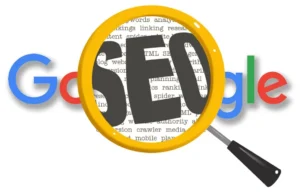
For businesses in Cardiff, SEO services are not just a luxury but a necessity. These services are designed to enhance visibility and online presence, ultimately driving more traffic and increasing sales. Whether you are running an eCommerce store or a local service-based business, the primary goal of SEO is to generate more enquiries and convert visitors into customers.
A Cardiff SEO agency can tailor a bespoke package to meet your unique needs, ensuring that your website is effectively communicating its relevance to your target audience. Focusing on metrics like return on investment reveals the financial impact of your SEO efforts.
Technical Search Engine Optimisation
Technical search engine optimisation is the backbone of any successful SEO strategy. It involves conducting thorough technical SEO audits to identify and resolve issues that might be hindering your website’s performance. Common problems like incorrect status codes and redirect chains can significantly impact your site’s rankings. Addressing these issues, enhancing site speed, and optimising for mobile will help your website achieve better search engine results.
Keyword Research
Keyword research is a critical component of any SEO campaign. It involves investigating user search terms and recording high-value keywords that can drive traffic to your site. Understanding your potential customers’ search terms allows you to tailor your content to their needs, thus improving your search engine rankings.
This process includes researching the market, analysing competitors’ websites, and considering factors like search volume, search intent, and competition. Effective keyword research ensures that your SEO campaign is set up correctly, targeting the most effective keywords for meaningful results.
On-Page Optimisation
On-page optimisation ensures that your website meets search engine guidelines and can be efficiently crawled. This involves optimising various elements, such as pages, headers, meta titles, meta descriptions, alt tags, permalinks, and body text. Focusing on these elements enhances your website’s relevance and visibility, resulting in better search engine rankings.
After completing the necessary audit fixes and on-page optimisation, many clients experience significant improvements in their search engine rankings. This process also includes using correlation analysis on top-ranking results to optimise your pages for target keywords.
Off-Page SEO Techniques
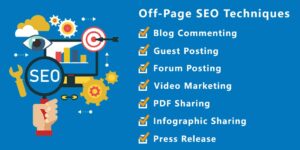
Off-page SEO techniques are essential for building your website’s authority and credibility. These strategies go beyond your website to enhance its reputation and drive traffic from external sources. By understanding user behaviour and the competitive landscape, you can implement effective off-page SEO methods that boost your overall website authority.
Key strategies include building quality backlinks, engaging in content marketing, and launching digital PR campaigns. These efforts collectively enhance your website’s visibility and improve search engine rankings.
Building Quality Backlinks
Quality backlinks from reputable sources are vital for improving your website’s domain authority and search engine rankings. Enhancing your domain authority boosts your site’s credibility, potentially leading to higher search engine rankings and increased organic traffic.
Clients can track the performance of their link building campaigns through a link tracking sheet, ensuring transparency and effectiveness. Implementing effective backlink strategies and carefully monitoring their impact can significantly boost your online visibility and drive more traffic to your site.
Content Marketing
Content marketing plays a crucial role in SEO by developing engaging material that attracts high-quality backlinks and drives traffic. Combining SEO techniques with compelling content forms a powerful strategy that enhances your website’s visibility and authority.
Proactively managing customer reviews and building a trustworthy reputation are also critical components of successful content marketing. Effective content marketing not only supports your SEO efforts but also helps build trust with your audience, ultimately leading to higher engagement and conversions.
Digital PR Campaigns
Digital PR campaigns are essential for businesses looking to enhance their online visibility through media exposure. Gaining media coverage elevates your brand’s reputation and attracts more website traffic. Effective digital PR campaigns help acquire authoritative links that boost your search engine rankings, making your site more credible and visible.
Partnering with a marketing agency that specialises in digital marketing PR can significantly improve your online presence and drive more traffic to your site.
Local SEO Services for Cardiff Businesses
Local SEO is crucial for businesses in Cardiff to connect with nearby customers and enhance their local visibility. Focusing on local SEO attracts customers from specific geographic areas, crucial for businesses serving the Cardiff area.
A trustworthy SEO agency, especially one based in Cardiff, will understand the unique challenges of the local market and can tailor strategies to meet the specific needs of your business. From optimising your Google Business Profile to managing local citations and customer reviews, local SEO services help improve your visibility in the local search results.
Google My Business Optimisation

Optimising your Google My Business profile is a critical step in enhancing your local search rankings and visibility in Google Maps. Ensuring your profile is complete and up-to-date significantly improves your chances of appearing in local search results. This includes providing accurate business information, engaging with customer reviews, and regularly updating your profile.
A well-optimised Google My Business profile can attract more local customers and drive more traffic to your website.
Local Citations
Local citations play a vital role in improving your local search rankings. Ensuring consistent business information across online directories and platforms enhances your visibility in the target market.
Managing local citations involves regularly updating your business information and monitoring your online presence to maintain accuracy. A consistent and accurate online presence can help you connect with local customers and improve your search engine rankings.
Customer Reviews Management
Customer reviews are essential for establishing trust and credibility with potential clients. Positive reviews can significantly influence the decision-making process of new customers, making it crucial to encourage and manage reviews effectively.
Strategies for encouraging reviews include follow-up emails, providing exceptional service, and implementing a reward system. Actively managing reviews by responding to both positive and negative feedback fosters community trust and can improve your local search rankings.
E-commerce SEO for Cardiff Businesses

E-commerce SEO involves optimising product pages, enhancing user experience, and focusing on conversion rates to succeed in the competitive online market. By implementing effective ecommerce seo strategies, businesses can dominate their market segment and achieve long-term sustainable improvements in search engine performance.
Product Page Optimisation
Optimising product pages is essential for improving search rankings and driving more sales. This involves integrating targeted keywords into product names and URLs, providing detailed product descriptions, and using high-quality images. Effective keyword research should consider competition and potential conversion rates to ensure that your product pages attract the right audience.
Optimising your product pages enhances your site’s visibility and increases conversions.
Category Page SEO
Category pages play a crucial role in capturing search intent and enhancing user experience. Structuring category pages to avoid competition with product pages and ensure easy navigation improves user engagement and search rankings.
Effective category page optimisation involves presenting clear information and aligning with user search intent to drive higher engagement and conversions.
Technical SEO for E-commerce
E-commerce businesses often face technical challenges that can impact site performance and user experience. Addressing these technical issues is crucial for optimising your site’s performance and ensuring a smooth user experience. An SEO agency with technical expertise can help identify and resolve these issues, improving your site’s search engine rankings and driving more traffic.
Focusing on technical SEO enhances your e-commerce site’s overall performance and yields better results.
Monitoring and Reporting
Monitoring and reporting are essential components of a successful SEO strategy. Regular tracking of SEO performance helps identify areas needing improvement and ensures alignment with client goals. Effective communication with your SEO agency includes regular updates and reports, providing clarity in strategies and demonstrating the value of SEO efforts.
Utilising real-time analytics, monthly reports, and user-friendly dashboards provides valuable insights into your SEO progress, enabling informed decisions.
Real-time Analytics
Real-time analytics provides immediate data about user activities, allowing for quick assessments of site performance and user engagement. This type of analytics is crucial for troubleshooting and verifying that tracking codes are functioning correctly. Real-time data helps monitor the effects of marketing campaigns almost instantaneously, revealing spikes in traffic or engagement as they happen.
Tools like Google Analytics 4 offer real-time reporting features, providing an overview of active users and their interactions on the site.
Monthly Reports
Monthly SEO reports provide a structured way to measure key performance metrics over time. These reports focus on key performance indicators, offering a comprehensive overview of your campaign’s effectiveness. By tracking these indicators, you can see how your SEO strategies are performing and make informed decisions.
Structured reporting helps clients understand their SEO progress, allowing for strategic adjustments in their campaigns.
Client Access to Data
User-friendly dashboards allow clients to access important data and insights effortlessly. These dashboards enhance transparency in SEO reporting, enabling clients to monitor their campaign progress and performance metrics in real-time.
Providing easy access to data keeps clients informed about their SEO efforts, enabling data-driven decisions to optimise strategies. This level of transparency fosters trust and collaboration between clients and their SEO agencies.
Choosing the Right SEO Agency in Cardiff

Selecting the right SEO agency is crucial for your business’s online success. The best SEO agencies in Cardiff, such as omniSEO, specialise in SEO and link building across South Wales, catering to local business needs. Choosing an agency that offers bespoke packages tailored to your website and online goals, while using ethical techniques, is crucial.
Reviewing client testimonials and case studies can provide insights into the agency’s track record and reliability. The right agency can significantly impact your online visibility and growth, making it a critical decision for your business.
Evaluating Experience and Expertise
Evaluating an SEO agency’s experience and expertise is vital for ensuring they can deliver effective results. A strong track record in delivering results demonstrates the agency’s reliability in SEO practices. Client testimonials provide insight into the experiences of others, showcasing the agency’s strengths and weaknesses.
Additionally, case studies illustrate specific successful strategies implemented by the agency, giving potential clients a clear picture of what to expect. Regularly updating skills through training and development ensures the agency remains aligned with current SEO standards and best practices.
Transparency and Communication
Transparency and communication are essential for building trust with your SEO agency. Compliance with search engine guidelines is achieved by using ethical, white-hat techniques. Clear communication ensures that clients understand the processes involved and the strategies being implemented.
Agencies like Caffeine Marketing recommend a long-term, content-led approach using ethical standards to achieve more traffic and better results. By maintaining open lines of communication, clients can feel confident in their investment and the efforts of the SEO team.
Customised Strategies
Customised SEO strategies are essential for addressing the unique needs of different businesses. Tailoring SEO strategies to align with specific business objectives can significantly enhance overall effectiveness. By understanding your business’s goals and challenges, an SEO agency can develop a marketing strategy that delivers results and maximises your online potential.
This personalised approach ensures that your SEO efforts are focused on achieving meaningful outcomes for your business.
Summary
In summary, comprehensive SEO services are crucial for businesses in Cardiff looking to enhance their online presence and drive more traffic. From technical SEO and keyword research to on-page and off-page optimisation, each aspect plays a vital role in achieving higher search engine rankings and better visibility. Local SEO services, e-commerce SEO, and effective monitoring and reporting further contribute to a successful SEO strategy. Choosing the right SEO agency, ensures that your business receives tailored, ethical, and effective SEO solutions. By investing in SEO agencies with a strong reputation in the Cardiff area, such as omniSEO, you can boost your online presence and achieve long-term success in the digital world.
Frequently Asked Questions
What is the primary goal of SEO services for businesses in Cardiff?
The primary goal of SEO services for businesses in Cardiff is to enhance visibility and drive more traffic, ultimately increasing online sales and generating leads for both eCommerce and service-based companies.
How does technical SEO impact my website's performance?
Technical SEO significantly improves your website's performance by addressing issues like status codes and site speed, leading to enhanced search engine rankings. Focusing on these aspects can ultimately help you attract more traffic and improve user experience.
Why is keyword research important for SEO campaigns?
Keyword research is essential for identifying the terms users search for, allowing you to target relevant keywords effectively. This ensures your SEO campaign is structured to achieve impactful results.
How do local citations improve local search rankings?
Local citations improve local search rankings by ensuring consistent business information across online directories, which enhances visibility in your target market. This consistency helps search engines trust your business, leading to better rankings.
What should I look for when choosing an SEO agency in Cardiff?
Focus on the agency's experience, transparency in their processes, and their ability to create tailored strategies that meet your specific business goals.
Top Tips for How to Improve Business Networking Skills in Cardiff
Want to know how to improve business networking skills in Cardiff? This guide offers practical tips and insights into local events, social media strategies, and community engagements. Learn how to build meaningful professional relationships right here from the leading SEO agency in Cardiff.
Key Takeaways
- Effective networking is about building genuine connections through small talk, active listening, and ongoing engagement, not just exchanging contact information.
- Leveraging local networking events and business communities in Cardiff, such as Sŵn Connect and Cardiff University workshops, can significantly enhance professional growth and opportunities.
- Confidence in networking can be developed through practice, mentorship programs, and continuous learning, providing a strong foundation for building lasting professional relationships.
Mastering the Art of Networking

Networking is not just about collecting business cards; it’s about creating genuine connections that can lead to long-term professional relationships. Mastering the art of networking involves understanding and utilising various techniques to foster these connections.
One of the fundamental aspects of effective networking is small talk, which can pave the way for more profound conversations and connections. Additionally, non-verbal cues such as body language and tone of voice significantly influence how messages are received. Maintaining eye contact and summarising points fosters active listening, essential for understanding others’ needs and interests. This helps in forming deeper connections, enhancing both personal and professional growth.
Moreover, effective networking is not just about exchanging contact information but fostering ongoing relationships. This means following up after meetings, offering value to others, and consistently engaging with your connections. This approach helps build a robust professional network that supports career development.
Leverage Cardiff's Networking Events

Cardiff is a city bustling with opportunities for networking. Local networking events provide great opportunities for professionals to expand their connections and collaborations. One notable networking event is Sŵn Connect, a music industry conference that offers free tickets for attendees interested in expanding their industry connections. The Connect panels at Sŵn Connect include discussions led by prominent figures in the music industry, aimed at sharing knowledge and experiences.
Cardiff also regularly hosts TEDx events, featuring speakers from various fields. These events provide a platform for fostering connections among attendees and encouraging discussions on innovative ideas. Additionally, industry-specific gatherings often include mixers that provide attendees with refreshments and informal networking opportunities.
Local mixers and informal gatherings offer key opportunities for effective networking in Cardiff. These events provide a relaxed environment to meet new people, exchange ideas, and build a professional network. Active participation in these events leverages Cardiff’s vibrant networking scene for career advancement.
Using Social Media for Professional Networking
In today’s digital age, social media platforms are powerful tools for professional networking. Different platforms serve unique purposes; for instance, LinkedIn is mainly for professional connections, while Twitter can be used to engage with industry influencers. Utilising groups and communities on platforms like Facebook and LinkedIn can facilitate discussions and connections with other professionals in your industry.
Sharing valuable content that showcases your expertise and relevance to your field is crucial for connecting with professionals. Interactions on social media, such as comments and shares, can enhance your visibility and help foster relationships within your professional networks. Proactively growing your network involves using search tools and recommendations to find and connect with professionals who share knowledge and similar interests.
Creating a professional profile that reflects your identity and goals is crucial for making a strong first impression on potential connections. By leveraging social media for professional networking, you can access a wealth of career opportunities and support from other professionals in your field.
Join Local Business Communities

Joining local business communities in Cardiff can significantly enhance your networking efforts. These communities provide support networks, workshops, tools, and resources crucial for business development. For example, Business Wales is a fully-funded business support service by the Welsh Government that assists entrepreneurs. Additionally, Cwmpas offers expert help and supporting across a wide range of areas for businesses.
The Enterprise and Start-up Team at Cardiff University provides networking, guest speaker events, workshops, and one-to-one advice for entrepreneurs. Project Start-up provides free online workshops and advice. They also offer mentoring to assist entrepreneurs in their journey. Alumni of Cardiff University can also access various entrepreneurial support services, including networking opportunities and guest speaker events.
Joining local business communities helps build connections, gain visibility, and access valuable resources. These communities are invaluable for entrepreneurs looking to develop their personal brand and make impactful connections.
Develop Your Elevator Pitch
An elevator pitch is a brief introduction that outlines your professional identity and goals, typically lasting between 30 to 60 seconds. Crafting an effective pitch requires identifying your unique attributes, what you’re looking for, and what you can offer to others. It’s important to adapt your elevator pitch based on the individual you are speaking with and the context of the conversation.
Ending your pitch with a question can encourage further conversation and engagement with your audience. For example, after introducing yourself and your goals, you might ask, “What projects are you currently working on?” This invites the other person to share and keeps the conversation flowing.
Developing a strong elevator pitch can significantly enhance your networking efforts. It allows you to quickly and effectively communicate your value, making a lasting impression on potential connections.
Engage in Online Learning and Webinars

Engaging in online learning and webinars is a great way to stay up to date with industry knowledge and develop new skills. The Knowledge Academy, for instance, provides 24/7 support for individuals undergoing online courses. Self-paced learning allows participants to complete courses according to their own schedules.
One notable course is the CCNP Boot Camp, which improves knowledge and skills in Cisco enterprise networks, routing, and switching. Participating in such a training course can help you gain valuable insights and expertise relevant to your field.
Engaging in online learning and webinars helps expand your professional network and keeps you informed about the latest industry trends and developments. This continuous learning approach is essential for career development and long-term success.
Build Long-Lasting Relationships
Building long-lasting relationships is a cornerstone of effective networking. Following up after meetings is important to nurture connections and demonstrate professionalism. Offering value to others, such as sharing knowledge or making introductions, builds trust in professional relationships.
Personalising interactions based on individual preferences helps strengthen connections and demonstrates commitment. Consistency in actions and communications is vital for establishing reliability in professional connections. Maintaining relationships on social media requires ongoing communication, such as checking in or sharing resources, to build trust and credibility.
Strong professional relationships can lead to opportunities for collaboration, referrals, and personal fulfilment. By focusing on the quality of connections rather than quantity, you can build a network based on shared values and mutual respect.
Attend Cardiff University Workshops
Cardiff University offers a range of workshops focused on business start-up, self-employment, and innovation, aimed at enhancing entrepreneurial skills. The university’s Enterprise and Start-up team provides one-on-one business advice and access to free start-up office space to help budding entrepreneurs.
Cardiff University also hosts competitions like the Spring Start-up Awards to encourage innovative ideas among students. These workshops include one-to-one business advice sessions tailored for aspiring entrepreneurs. A mentorship program at Cardiff University has successfully matched 221 students with industry mentors, enhancing students’ professional networks and career insights.
Attending these workshops can provide valuable training and networking opportunities, helping you develop your business ideas and achieve your career goals.
Gain Confidence Through Practice
Confidence is key to successful networking, and practice is essential for building it. Practicing in low-pressure environments, such as casual meetups or online groups, can help ease the anxiety of networking. Setting manageable goals, like initiating three conversations at an event, can help maintain focus and reduce pressure.
Visualisation and positive self-talk can significantly enhance confidence before engaging in networking situations. Breathing exercises and relaxation techniques are effective strategies to calm nerves before networking events. Preparation, including understanding the event format and having conversation starters ready, is crucial for managing networking anxiety.
Consistent practice of networking skills builds confidence and improves effective communication in professional settings.
Utilise Mentorship Programs
Mentorship is a vital aspect of professional development that offers guidance and support from experienced individuals in your field. The King’s Trust offers a free Enterprise programme that supports young people in starting their businesses through workshops and one-on-one mentorship. Networking mixers at Sŵn Connect feature opportunities to meet industry mentors, providing attendees with access to professionals in the music field.
Participating in guest speaker events allows individuals to gain insights from successful entrepreneurs and can foster valuable networking relationships. By utilising mentorship programs, you can access valuable advice, resources, and support to help you achieve your career goals.
Summary
Networking is an essential skill for career development and professional growth. By leveraging Cardiff’s networking events, using social media effectively, joining local business communities, and developing a strong elevator pitch, you can create meaningful connections and advance your career.
Engaging in online learning, building long-lasting relationships, attending Cardiff University workshops, practicing networking skills, and utilising mentorship programs are all crucial steps to becoming a successful networker. Start implementing these strategies today, and watch your professional network grow.
Frequently Asked Questions
What are some key techniques for mastering the art of networking?
Mastering networking involves mastering small talk, paying attention to non-verbal cues, actively listening, and focusing on building meaningful connections. Embracing these techniques can significantly enhance your networking skills and opportunities!
How can I leverage Cardiff's networking events?
You can effectively leverage Cardiff's networking events by attending gatherings like Sŵn Connect and TEDx, as well as local mixers to make valuable connections. Embrace these opportunities to engage with others and expand your network!
How can social media help with professional networking?
Social media is a powerful tool for professional networking, allowing you to connect with industry influencers and engage meaningfully through platforms like LinkedIn and Twitter. By sharing valuable content and participating in discussions, you can expand your network and open up new opportunities.
Why is it important to join local business communities?
Joining local business communities is essential as they offer valuable support networks, resources, and workshops that can significantly enhance your business development. Embracing these connections can lead to inspiring growth and opportunities!
How can I develop my elevator pitch?
To develop your elevator pitch, start with a clear introduction of who you are and your goals, then wrap it up with an engaging question to spark further conversation. This approach will help you connect meaningfully and leave a lasting impression!
How to Make Your Blog Posts SEO Friendly
How to Make Your Blog Posts SEO Friendly
Wondering how to make your blog posts SEO friendly?
Then you're in the right place!
As the leading Cardiff SEO agency, we've published millions of words of content for hundreds of sites and businesses over the years.
Today we're going to cover everything you need to know to write a high quality blog post that will rank in Google, bring your site relevant traffic, and increase your overall authority.
Scroll down to get right into it but first, for those who are new to the idea - why does this matter at all?
Why Write Blog Posts for SEO?
Writing blog posts allows you to target lower competition keywords, that are easier to rank for that high competition commercial and service keywords. They also allow you to cover a broader range of topics, be seen as an authority in your niche, and bring your site or business to the attention of web users who are looking to answer specific questions related to your niche.
For example, let's say you're a plumber in London. Obviously, your main goal will be to rank for keywords like "London plumbers" and "plumber in London", since these will likely be the highest searched keywords in your niche and people typing them are highly likely to become paying customers.
But every other plumber in London will be trying to rank for these terms too, making them highly competitive. This means ranking for them may take quite a while and cost a fair bit of money.
It's still a good goal to have, but you will also find longer tail, more specific keywords, usually asking a specific question around plumbing. For example "what is the hourly rate for a plumber in London", "how to plumb in a dishwasher" or "does home insurance cover plumbing".
Writing quality posts answering these questions is an effective strategy because:
- These keywords are going to be much less competitive than the basic plumbing keywords mentioned above, meaning you can rank for them much more quickly, easily and cheaply (possibly not even needing any backlinks at all for the lowest competition ones).
- Answering these questions in detail will help Google see you as an authority on the topic, increasing the ranking power of your entire site. It can also have the same effect on readers, leading to your site being seen as one of the most authoritative in your niche and encouraging people to come back to learn more.
- These posts will mostly be read by people looking to learn more about plumbing, so by positioning yourself right and effective use of calls-to-action, you can drive many of them to your service pages and turn them into paying customers (more on this later).
Now that you hopefully understand the power of writing blog posts for SEO purposes, let's jump into the how.
We will break down all the major things you need to write and optimise an effective SEO blog post, but first, there is one rule above all else:
Write Good Quality Content

This is rule number 1 and the main thing to keep in mind at all times.
The content you produce has to be good quality, clear, easy to read, and answer the question thoroughly for anyone who's reading it.
If it doesn't do this, it will never achieve anything, even if you nail every other tip on this list.
After all, if a post is good, readers click on it more often, spend more time on it, and other sites link to it. These are all factors that support and boost your rank in Google.
If none of these things happen, the post is unlikely to ever rank well or achieve much.
Optimise for Keywords
If your content doesn't contain any keywords, it isn't going to show up in any searches, it's as simple as that. It could be the best post on the topic, and it still won't matter if nobody finds it.
If there is one primary keyword you're trying to rank the post for, otherwise known as your "focus keyword", this should be in the title for the post, and be the main "slug" of the URL.
If there are other relevant keywords you need to use too, fit them in where relevant - they often make great H2s that allow you to go more in depth onto specific subtopics. These will help to tell Google what your post is about and ensure it ranks for other keywords beyond the focus keyword, giving you the best chance of higher traffic from relevant searches.
Focus on Readability
Readability is key at all times. Only a small percentage of people actually read a blog post from start to finish.
The vast majority have searched to find out a specific piece of information and are simply skim reading until they answer that question.
According to HubSpot, the average person spends 35 seconds reading a blog post.
There are two lessons here. The first, is to make your writing for your blog posts as concise and simple to read as possible.
It should be equally easy to read for a expert in the field or a 10 year old.
The second, is to use typology techniques like underlining, italics, bolding, colours, and highlighted sections to bring the readers eyes to the parts of the page you most want them to see.
Understand Search Intent
One of the most important things to get your head around, is understanding the intent of specific keywords.
In other words, what is the searcher looking for, and what is the most efficient way to provide it?
For example "SEO keyword research" could be someone looking to understand what keyword research is, or looking for professionals to carry it out for them. But if someone types "keyword research guide", you can assume they're looking for an explanation on how to do it themselves.
Obviously this gets quite a lot more complicated when you're looking at large lists of different keywords and subtopics, but the point remains the same - understanding what a person may be thinking or hoping to find when typing a specific search will help you tailor your content to them more effectively, which results in more clicks, more time spent on page, more backlinks, and therefore more traffic and authority.
Solve Problems Your Audience Face
When planning a specific blog post or piece of content, it's a great idea to put yourself inside the head of someone who's searching for it. Why would they be searching for it specifically? What are they trying to achieve with that knowledge?
By adding a little extra something to solve the issues they're facing, you can make your content more valuable and helpful, which also makes it more linkable.
Going back to the "keyword research" example used above, consider making a video of you doing your own keyword research. This gives newcomers to the idea an easier way to understand the process vs just reading through the basics of what keyword research is. It is also more likely to offer something new to someone who is already experienced in the topic.
Use an Attention Grabbing Title

This is the simplest tip anyone can give you, but it is also easily overlooked. Your title will be the first thing anyone sees when your blog shows up in the search results, and is often the only thing they have to go off when deciding whether to click on it or not.
The key is to use clickbait techniques, without going all the way into clickbait, since straight up lying about the content is more likely to annoy people that draw them in.
Calling on techniques such as urgency or scarcity (don't miss out on this!), emotional triggers (this will scare you!), or hinting at something in the title without fully explaining it will go a long way to drawing people in.
Include Calls to Action if Relevant
If your blog posts are intended to bring traffic to core pages on your site such as product pages and service pages, you will need to do more than just link to those pages. While a simple hyperlink in the middle of some text is enough to send some authority to other pages, it isn't very tempting for a user to click on. Using a call to action is one of the most reliable and proven ways to push the click.
Optimise Meta Tags
Optimising your meta tags is the simplest and easiest way to improve the optimisation of a blog post. The title should match the h1 and URL slug to give Google absolutely no chance to misunderstand what the post is about. Equally, the meta description can basically be viewed as a free advertisement, giving you a chance to sell the post to people viewing it in the search results and encouraging them to go ahead and click.
Include Images & Videos
Images and videos help a posts rankability and increase the time users spend on the page too - as long as the media is relevant, informative and high enough quality for people to actually want to look at it. Images should be small enough to load fast and well optimised in terms of file names and alt tags.
Create the Best Post on the Topic
You're more than likely writing a blog post on a topic that's already been covered. If this is the case, you need to make it better than what's already available. If not, why would anybody want to link to you, and why would Google give you a good rank?
Better quality will fly up the ranks and people will naturally ink to it as a genuinely positive resource, which makes everything else easier going forward.
This is known as the skyscraper method and becomes more important the more competitive the topic is.
Hire a Professional
If you stick to the list of tips used here, it can be relatively easy to create a high quality blog post that performs well. But if you'd rather spend your time elsewhere, safe in the knowledge that this is being done effectively, consider hiring a professional. OmniSEO is Cardiff's leading SEO agency and is highly experienced in producing high quality content for all niches and industries.
SEO Blog Post Checklist
Now that we've covered the most important tips for writing an SEO blog post, here is a handy checklist for the main things to include. If you're writing good, clear content that covers all of these bases, you're in a good place
- Short sentences & Brief Paragraphs
- Clear Subheadings
- Bulleted Lists
- Visual Elements
- Avoid Keyword Stuffing
- Title Tags
- Slug/URL
- Meta Description
- Optimised Images (Alt Tags, Speed Etc)
- Geotagging for Local SEO
- Site Architecture
- Technical SEO
How Often Should You Do an SEO Audit?
How often should you do an SEO audit?
It's something new or potential clients ask us often.
In this post we'll breakdown the types of audits you should do and how regularly, but first, what are they exactly?
What is an SEO Audit?
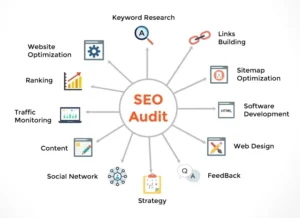
An SEO audit is a careful process that involves analysing a website's ability to index, rank and perform well in search engines. A comprehensive audit includes identifying strengths to leverage, spotting weaknesses that need to be remedied or removed, and making a clear path to improvement.
A comprehensive SEO audit needs to cover all important aspects of search engine optimisation in order to confirm that a site is upholding the most important SEO best practices, or at least to identify those that are missing. Less comprehensive SEO audits may focus on specific areas, for example a technical SEO audit may only focus on the technical issues preventing a site from performing well, rather than its overall SEO strategy.
Before we go deeper, let's quickly cover what is included in an SEO audit:
Technical SEO Audit
- Site Structure: Checking that the overall site structure is clean, easy to navigate and crawl, and provides a high quality user experience
- Mobile Usability: Checking how the site displays, works and responds across multiple device and screen sizes, with a focus on speed and layout
- Search Console/AHrefs Errors: Spotting crawl errors, broken redirects, slow loading content, security issues, etc.
- Basic Web Performance & Vitals: Is the site working in in terms of interactivity, does it load quickly, are canonical tags correct?
On Page SEO Audit
- Content Relevance and Quality: Each individual page or blog post needs to be high quality, readable, authoritative, and contain relevant information to the topic it's trying to rank for. Google judges this by the language used so be sure to use as many relevant keywords as possible.
- Meta Tags: Titles and descriptions need to not only match the content of the page as accurately as possible, but should essentially be used as a free ad, using copywriting skills to draw users to click on the page.
- Internal Links: The link structure must be analysed and improved in order to ensure it offers both easy navigation and appropriate distribution of page authority.
- Headers: Headers must be used appropriately to structure content, with it being clear which sections are the focal point of each post and navigation throughout the content being logical and natural. Effective use of headers can improve readability, accessibility, and give an opportunity to rank for more relevant keywords beyond the focal key phrase.
- Images: Images must be compressed correctly for optimal loading times, have clear descriptive file names and alt tags, and be relevant to the pages they're displayed on, adding to the depth or readability of each content piece.
- Site Architecture: Sitemaps must be current for optimal crawlability, robots.txt should be implemented effectively to direct crawls, and connections should be secure with HTTPS for trust (this helps with ranking too).
- URLs: URLs should be clear, relevant to the page, concise, easy to read and contain the main keyword you're trying to rank for.
Off Page SEO Audit:
- Backlinks: If you have any experience with SEO at all, you'll be aware that they are one of the most important metrics when it comes to ranking in competitive keyword and gaining relevant traffic. If a site or page doesn't have enough backlinks, it won't be visible in high positions in search engines. If everything else is done right already, then pointing some extra backlinks can be the difference between success and failure.
- Rankings: Why rankings are the goal, and sometimes a long term one, checking them during an audit is one of the best ways to see how things currently stand, what isn't working, and how to adjust tactics going forward.
- Social Signals: While the impact social media engagement has on SEO is still under debate, it does seem to have some impact, and should be considered when building an overall SEO strategy.
Now that we've broken down the basic types of audits, on to the main question:
How Often Should You Perform an SEO Audit?
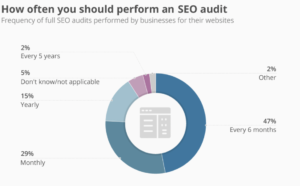
Whether you're doing an SEO audit for your own business, or you're doing it for a client as part of an SEO agency, the basic task can be considered a bit like spring cleaning. It's not something you need to do every day, or even every few days, but if you ignore it entirely, soon problems will start to mount up.
How often you need to carry out an SEO audit varies depending on the site or what your priorities are, but a few factors to keep in mind include:
- The current state of technical SEO. If you've just began working on a site and there are a large number of technical errors, it is a good idea to work your way through them and cut them down as quickly as possible. Similarly, if you're already on top of the technical side of things, you may be able to get away with only doing this every few months.
- The size and complexity of the site. The larger it is, the more often you should run audits.
- Competition within the same niche. If they are on top of regular audits, you should be too.
- Relationship between web traffic and the company's bottom line. If this is minimal then you can get away with less audits. If the business relies heavily on revenue from search engine traffic, then evidently, you cannot.
On top of the obvious, it is also a good idea to run an audit when you see a significant update to an algorithm, when the site goes through a major update, and/or when you see a major ranking change, since any of these can change your SEO standing and strategy entirely.
Why are SEO Audits Needed This Often?
It's tempting to just assume that you're done once you've designed or updated a website and addressed the glaring issues, that you're done with audits and everything will stay good. Unfortunately, that's not the reality we live in. Web design and SEO can be messy, images and links can break, and one small tweak to a page can have other effects you never imagined. Even with no changes at all, competitors can make sweeping moves that reduce your competitiveness, and algorithms can update changing your ranks overnight.
Just like people need a checkup from the GP once in a while, websites need regular audits. The most important thing to consider here is crawlability and user experience - after all, if neither Google nor the user can efficiently find their way around your site, then you're fighting a losing battle even if everything else is perfect.
While maintaining a site health score of 100% all the time is unrealistic, it's a fair goal to aim to always be above 90%. A score of 70% or lower is likely to mean there are some major issues that need to be addressed soon. Of course, this varies depending on niche, so if all your competitors of 95% or above then you're going to have to hold yourself to a higher standard too.
It's important to remember that Google won't necessarily reward you for keeping on top of technical SEO, but it will punish you for failing to do so.
Some important errors to look out for include:
- A low health score
- Broken links
- Duplicate content
Other factors that may not flag up as a specific error but that are just as important to spot and action include:
- Increased bounce rate
- Increased cart abandonment
- Reduced average session duration
What is Included in an SEO Audit?
To keep things simple, here is a list of the main things to check in an SEO audit:
Technical SEO Audit
- URL structure
- Page & site loading speed
- Crawlability
- Duplicate content
- Canonical tags
On Page Audit
- Keyword research
- Site content structure
- Metadata
- Broken links
- User experience
If you don't have time to carry out your own SEO audit, consider signing up for a FREE SEO Game Plan from omniSEO, the leading SEO agency in Cardiff. This is one of the easiest ways to get some free professional advice on what your site needs next.
How Do I Choose Keywords for SEO?
If you're at the early stages in your online marketing or SEO journey, "how do I choose keywords for SEO" is likely one of the biggest questions on your mind.
Keyword research has been a constant in SEO since the beginning, and is arguable the most important part of the entire process.
At its core, SEO is all about ensuring your website or specific web pages show up in the search results for specific keywords. But choosing the right or wrong keywords to target can be the difference between experiencing massive growth and experiencing...nothing at all.
While an effective SEO strategy is a science, combining well-done on page optimisation with efficient site structure and carefully selected backlinks to boost your website's rankings, keyword research can often be more of an art, as you have to be carefully examine the related keywords to your niche, consider what people may be thinking or looking for when searching each one, and select the one that is most likely to be entered by your ideal customer.
As the UK's leading Cardiff-based SEO agency, we are able to do this for you to a high standard, and our money back guarantee means this comes at no risk to your business.
If you'd rather figure out how keyword research works and do this for yourself, you're in the right place, as this post will breakdown everything you know.
Since some of you are probably new to the entire concept of SEO, let's start with the basics:
What is Keyword Research in SEO?

Keyword research is the process of finding keywords that people regularly enter into search engines, and analysing the potential of using that data for a specific business purpose. Usually, it means finding keywords that are likely to be searched by people that would be interested in your business, with the intent of ranking content or service pages for that keyword. The end result, if done correctly, is people searching those keywords begin to be made aware of your service or product.
SEO professionals analyse many things when judging a keyword, for example:
- Intent: Is the person typing this keyword likely to be looking for what we're offering? Or could they mean something else?
- Search volume: Is the keyword searched often enough that ranking for it in a search engine results page is likely to bring notable traffic to our website?
- Competition: Is the keyword low competition enough that we can rank for it easily and quickly? If not, are we willing to invest the time and funds necessary to compete?
Intent is a bigger deal than you may at first think, since it will dramatically affect how people react to seeing your website show up in the search results.
For example, there would be no point whatsoever in ranking a top of the line, premium laptop for the keyword "cheap laptops". People entering that into a search engine are specifically looking for a bargain, and are highly unlikely to be interested. Rank a heavily discounted or second hand laptop in this keyword, however, and you're likely to get a much better response.
While this is an example designed to be easy to understand, intent can get much more complicated than this, with many words having multiple meanings. It is important to analyse keywords carefully and always recommended to go for the ones that are the closest match.
If you're ever unsure whether a keyword is a good match, it's always a good idea to simply enter the keyword in Google to see what's already ranked, since this will give you a good idea what people searching the term are looking for.
Why is Keyword Research Important?

Keyword research helps you make your SEO strategy more efficient. Just taking a "spray and pray" approach to any keyword that may be relevant is likely to result in a lot of wasted time and effort.
You want to aim for the sweet spot of keywords that are low competition enough to rank for, searched highly enough to actually benefit you once ranked, and that cover topics you can reliably produce great content on.
It also helps you to understand your target audience, what they're likely to look for in Google, and how closely that matches with what your website is offering them, potentially making you aware of missing services you should be offering, or content gaps you need to cover.
One of the biggest mistakes newcomers to SEO make is simply guessing what they think people would call the service or product they're offering, essentially making up their own keyword instead of selecting one based on real data. If you base your content strategy on a keyword like that, you may well receive zero additional traffic, even if you produce the best piece of content the internet has ever seen. If nobody is searching for it, Google has nobody to proudly show it to.
When we begin working with newly onboarded clients, keyword research is usually the first task we carry out, since it tells us how many people search for what the client is offering, what they tend to search, and this is information that can inform every other task and strategy going forward.
Benefits of Effective Keyword Research
Carrying out keyword research to a higher standard will offer many benefits, including:
- Increased traffic: The more relevant keywords you rank for, the more traffic your site will receive as a whole. Even if the individual keywords are low search volume, ranking good quality content for more and more of them will put your website in front of more people over time.
- Insight into trends: Conducting regular keyword research will mean you are likely to be made aware earlier when a new relevant keyword starts being searched by someone, or when an existing keyword is increasing or decreasing in search volume. Using this knowledge intelligently will allow you to get content in front of even more people, potentially even ranking for keywords that are growing in demand before they become too competitive.
- Increased customer base: If you provide the right type of content that appeals to the right audience, and put effective calls to action in it, then you will be grabbing a certain percentage of your traffic and adding those people to your customer journey. Once this is done effectively, it will compound over time as you add more and more content and overall site traffic grows.
Search Intent
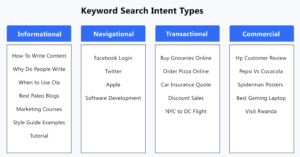
As an SEO professional, or someone doing their own internal SEO, search intent is likely the most important area for you to understand.
It's not just the keyword itself you need to get your head around - it's why somebody would be searching that keyword and what they're hoping to find.
The content that you're trying to rank has to be the perfect answer, and solve the problem of the person searching - otherwise, it's useless and unlikely to succeed.
Think about this post - you probably got here by searching something keyword research related. If you had been searching for a car showroom, would you have read this far into the post?
How to Choose Keywords for SEO
When it comes to actually conducting keyword research, how do you compare and judge the keywords?
We'll take you through some basic steps to help you understand the process more easily.
Step 1: Find a tool for checking on keywords

To start this off, you'll need a way to check Google keyword search data. The most reliable and effective way for SEO agencies to do this is to use a software tool called AHrefs. This is also the most expensive tool for this purpose, however, and can only be recommended for larger businesses who can easily afford it.
For those with a tighter budget, there are other great tools out there such as SEMrush and Moz. These are mostly less advanced than AHrefs but are still excellent tools that provide accurate data. Most companies that don't want to shell out for AHrefs monthly price will be more than happy with these.
Lastly, if you're a cash strapped freelancer or a very small company, you may struggle to pay for a tool at all in the early days. If this is the case you can actually begin typing queries into Google. The autocomplete feature will finish them off for you with multiple suggestions. By doing this multiple times with different words and letters, you can get a large amount of suggestions for what people commonly search in Google. Unfortunately this method doesn't come with more in depth metrics given by the tools listed above, such as monthly search volume and keyword difficulty. However, for those without access to such tools, this is a great way to find possible keywords to target.
Step 2: Break down keywords into specific lists or "buckets" based on topic

Once you have a tool or method to find keywords, it's time to think of all of the main topics you want to cover. There will likely be a main topic that you already have in mind, but consider others that may be worthwhile too.
For example, if we were doing keyword research for our SEO website, clearly we need to cover SEO-specific keywords such as "SEO agency UK". But it may also be worth covering adjacent topics such as "blogging", "digital marketing", "lead generation", etc.
By breaking these down into separate lists, you'll have a list of keywords ready to go each time you go to create content around a specific topic.
Step 3: Analyse the intent of the keywords and judge accordingly
You now need to consider what types of content would be best for each group of keywords, in order to match the intent as well as possible.
For example, as an SEO agency, we may see a list of keywords based around services for specific eCommerce platforms. For example, "wordpress SEO" or "webflow SEO services. As an eCommerce SEO agency, it makes sense that we should make pages targeting each of these.
It's also important to note the differences between keywords like "buy blog posts" which is clearly looking for a service, and keywords like "how to write a blog", which, while being on the same topic, is clearly looking for information instead.
Since it's best to tailor your content to exactly what a searcher is looking for, in this position you would be wise to make two different pieces of content entirely. You can make a service page called "buy blog posts", rank it for that keyword, focus it on pushing your service and making sales. At the same time, make a post called "how to write a blog", which is purely informational and answers the question in depth, without trying to sell the service too much. You can then use a subtle call to action at the end linking to the service page. The end result is that both content pieces are pointing traffic to the parts of your site that make money, but both are addressing the search intent correctly too.
If you're ever unsure what the intent of a keyword is, a simple trick is to search it and see what's already ranking well.
Once you have completed these steps, you will likely have a content plan that will keep you busy for a long time - the key is to get a solid ranking in any keyword that appears to match up with the service, product or content you're offering, ensuring every searcher that may be interested in your site gets a chance to view it.
Why is SEO Important for Businesses?
Why is SEO important for businesses?
It's a question that likely comes up often, as small businesses need to compete for visibility, both on a local scale and a global one, and SEO is often touted as the solution.
If you're looking to boost brand awareness, get your product or service in front of the right people, and grow your business, SEO (search engine optimisation) is crucial, whether you go into the trenches to learn how to do it yourself, or you hire an expert.
SEO is important for a lot of reasons, and we're going to break some of them down for you today.
1. It provides an excellent return on your investment

It's important to remember that, when done right, SEO always provides an excellent return on your investment.
Firstly, if you decide to study SEO and carry it out, it can actually cost you nothing but time. While that may be a significant amount of time, if you approach it correctly everything you do will contribute towards growing your business.
Of course, not everybody has the SEO knowledge or time to actually do that. And even of those who do, many may choose to outsource their SEO to an agency anyway, preferring to focus all of their time on doing what they do best and growing their business.
But even hiring an SEO agency, if done properly, provides an excellent return on your investment. Of course, you need to be safe in the knowledge that you've gone for a respectable agency that knows what they're doing, and one who's pricing is within a reasonable, manageable budget.
But there are SEO agencies out there such as omniSEO, who offer both a free action plan to explain to you exactly what your site needs, and a money back guarantee if they don't do what they say they will do, meaning the risk involved in hiring them is quite literally zero.
Yes, SEO is a crowded space nowadays, and there are agencies and freelancers out there with poor skills or absurd prices. But it only takes a little research to avoid them, and by sticking to SEO service providers whop are reputable and honest, OR by carry out SEO yourself and continuing to improve your knowledge, it isn't difficult for long term growth to be guaranteed.
2. It supports your content marketing efforts
Creating great quality content, and using SEO best practices, is something that comes together like bread and butter.
Creating amazing content isn't gonna achieve anything if nobody sees it. But optimising each piece of content correctly will mean your videos, images, and blog posts rank well separately from your service pages or product pages, and bring in regular, relevant traffic in the long term.
Not only does this benefit the content itself, but with proper use of CTAs (calls to action), they can all point pre-sold traffic to your site.
Google rewards you for this with higher rankings too, making a compounding benefit that continues to improve your business over time.
3. It boosts your authority and credibility
If your site is ranked highly in Google in relevant search terms, this means Google thinks you are trustworthy, high quality and relevant enough to be offered to people looking for those keywords.
This respect is passed on to those who see you coming up high in the search results, as they're not only more likely to click on your site and potentially become customers, but they are also more likely to remember you and use you in the future, or recommend your business to others.
Being so highly regarded also makes it more likely that other businesses will reach out to you to collaborate or use your services, since they are more likely to know how much time and effort is involved in an effective SEO campaign.
4) It benefits and boosts your paid ad campaigns
Paid ad campaigns work incredibly alongside effective SEO, and for those with the capital to invest in both, should be seen as two sides of the same strategy.
Having your pages rank organically at the top of the search results, while your paid ads also display above that, boosts your brands credibility and creates a feeling of clearly standing out above the crowd.
You can also use PPC to boost your SEO results, for example paying for extra traffic to a page that is already organically ranked well, especially if the keywords are low cost per click.
5) It increases awareness of your brand

Most marketing campaigns focus on a very specific target audience. And while SEO is no different, different stages of your conversion funnel provide opportunities to attract anyone with the correct intent, even if those audiences are slightly different.
This requires excellent keyword research and prioritising those keywords that are closest to the correct intent and relevance, but if done correctly, the people most likely to be interested in your offerings will be consistently made aware of them, at the exact time they're looking for that sort of thing.
6) It increases your competitiveness within your industry or niche
There is a high chance your competitors are investing in SEO, especially the more significant ones. You therefore cannot really compete with them without an effective SEO strategy to build your own ranks and traffic in a similar, ideally more effective, way.
It's important to remember that 90% of people who search in Google end up choosing to click on something on page 1, so if you're not there, you might as well not exist.
Of course, even if your competitors aren't investing in SEO, there is nothing to say they won't get their act together and start one day. This means you should be doing it anyway, with a target of getting as far ahead as possible.
7) Local SEO is a game changer
If you're a business that primarily looks for clients or customers in the nearby area or region, such as plumbers, builders merchants or, ironically local SEO agencies, local SEO may well be the most important thing you ever do. It ensures that local potential buyers who are currently ready to buy, are pointed towards your business rather than a competitor, or even a non local business.
The first step is setting up a Google My Business account, listing the correct contact details, and beginning to accrue positive reviews. After this you can optimise specific pages for local searches and gain local citations to boost your authority. OmniSEO are experts in local SEO and can do this quickly and effectively in any area or industry. Consider getting in touch if you need help with this, and remember the money back guarantee makes this risk free.
8) It improves the user experience
SEO, when done correctly, encourages you to provide a sensible site structure, fast loading pages, an easy to understand user experience, and even to regularly tackle any technical issues that may arise.
By doing this and staying on top of it, you aren't just improving your site for Google, you're improving the experience of everyone that visits it too.
9) Results are quantifiable and undebatable
Sometimes, marketing results can be wishy washy. If you hire a copywriter to redesign a billboard, for example, you may not notice any difference to your business. You can even completely launch a new website and experience little to no benefit, if it is done with a poor web designer or without an effective strategy driving it.
Not the case with SEO. It's easy to see how many people visit your site each day, week, month or year. It's easy to see which pages and keywords they come from. It's just as easy to see how many of those people turned into paying customers. This means that it won't take much time for you to figure out if your SEO strategy is effective or not, and how much of a return on investment you're getting.
This allows you to tweak further. If you're not getting the return you expected, the strategy likely needs to be revisited. If you are consistently getting a significant return, then you will likely feel the confidence to step things up and invest even more. Either way, the full picture is easily available and the power is in your hands.
As you can see, SEO has countless benefits for businesses and really should be a priority for any business looking to grow or gain new customers.
At omniSEO, we are the leading UK and Cardiff SEO agency and provide local, national and global results for companies all over.
To learn more, go to About us.
Cardiff for Startups: Top Opportunities and Resources to Grow Your Business
Cardiff for Startups: Top Opportunities and Resources to Grow Your Business
Is Cardiff a good place for startups? We think so!
Cardiff is emerging as a prime location for tech, health, and creative media startups, thanks in part to its growing population, innovation hubs, ample networking events, and access to venture capital. The city also offers support programs like government grants, mentorship initiatives, and university partnerships to help new businesses thrive.
Cardiff's Thriving Startup Ecosystem

Cardiff is quickly emerging as a hub for startups in technology, health, and creative media. The city’s ecosystem flourishes with a wealth of resources and opportunities that nurture entrepreneurial growth.
From innovation hubs to networking events and access to venture capital, Cardiff offers a comprehensive support system for startups.
Innovation Hubs and Co-Working Spaces
Innovation hubs and co-working spaces are the lifeblood of Cardiff’s startup scene. These dynamic environments foster collaboration and creativity, providing startups with the perfect space to grow their ideas. Tramshed Tech, for instance, is renowned for its strong community connection and collaborative spirit, making it a pivotal innovation hub in the city. Similarly, co-working spaces like Da, located conveniently near train stations in Cardiff and Swansea, offer a community-focused environment with excellent amenities.
These hubs not only provide physical space but also host workshops and events that bring together entrepreneurs, investors, and industry experts. The vibrant atmosphere in these spaces significantly contributes to the collaborative and creative culture that startups in Cardiff thrive on.
Whether you’re looking for a place to brainstorm, network, or simply get some work done, Cardiff’s innovation hubs have got you covered.
Networking Opportunities
Networking is the cornerstone of any successful startup ecosystem, and Cardiff is no exception. Regular networking events in the city facilitate connections between startups and potential investors, providing a platform for businesses to present their ideas and gain valuable insights from industry experts. These events are crucial for startups looking to grow their business, as they offer opportunities to discuss ideas, join forces, and build lasting connections.
From informal meetups to large-scale conferences, Cardiff offers a wide range of networking opportunities that cater to startups at different stages of their journey. These events not only help in building relationships but also in accessing the resources and support needed to navigate the challenges of the startup world.
Engaging in these networking opportunities allows startups to harness the community’s collective knowledge and experience to advance their business.
Access to Venture Capital
Securing venture capital is often a critical step for startups looking to scale, and Cardiff provides ample opportunities in this regard. The city hosts several venture capital firms that actively invest in local startups, offering the financial support needed to turn innovative ideas into successful businesses. Moreover, various programs in Cardiff aim to assist startups in securing pre-seed funding and enhancing their operational capabilities.
These programs offer a blend of financial, educational, and mentorship support, ensuring that startups have the resources they need to thrive. Accessing Cardiff’s venture capital ecosystem provides startups with the necessary capital to fuel growth and achieve business objectives.
Whether you’re developing the next big tech innovation or a groundbreaking healthcare solution, Cardiff’s venture capital landscape provides the financial backing to make it happen.
Support Programs and Initiatives
Cardiff’s startup ecosystem is bolstered by a variety of support programs and initiatives designed to help new businesses thrive. These initiatives connect startups with essential resources, expertise, and networking opportunities, significantly aiding their growth and development.
From government grants to university partnerships and mentorship programs, Cardiff offers a comprehensive support system for startups.
Government Grants and Incentives
Startups in Cardiff can take advantage of various government grants and tax incentives aimed at fostering innovation and economic growth. These financial assistance programs are tailored for new businesses, providing the funds needed to get off the ground and sustain growth. For instance, Start-Up Loans Wales offers up to £25,000 for early-stage businesses, accompanied by a year of free mentoring.
In addition to grants, tax breaks and other incentives are designed to encourage investment in startups within Cardiff. These benefits can significantly reduce the financial burden on new businesses, allowing them to reinvest in their operations and drive innovation. These government incentives provide startups with crucial financial support, aiding in their growth and success.
University Partnerships
Partnerships with local universities are a cornerstone of Cardiff’s support system for startups. These collaborations provide startups with valuable research opportunities and access to a skilled talent pool. Local universities offer access to research facilities and expertise, helping startups to develop innovative solutions and bring them to market.
Programs like Accelerate, backed by local universities, support startups in translating healthcare innovations into market-ready solutions. Engaging with the talent pool of students and graduates offers startups fresh perspectives and innovative ideas.
These partnerships not only enhance the capabilities of startups but also contribute to the overall growth of Cardiff’s entrepreneurial ecosystem.
Mentorship and Accelerator Programs
Mentorship and accelerator programs in Cardiff play a vital role in helping startups scale and achieve success. These programs provide structured guidance, networking opportunities, and access to resources that are crucial for startup growth. Numerous initiatives connect aspiring entrepreneurs with seasoned industry professionals, offering the mentorship needed to navigate the challenges of starting and growing a business.
Accelerator programs, in particular, offer a comprehensive support system that includes financial assistance, educational resources, and mentorship. Participation in these programs equips startups with the insights and skills necessary for effective scaling and business success.
Whether you’re looking for guidance on product development or strategic planning, Cardiff’s mentorship and accelerator programs provide the support you need to succeed.
Key Sectors Making Waves in Cardiff

Cardiff’s startup scene is characterised by a diverse array of sectors that are making waves in the industry. From tech and machine learning to health and biotech, and creative and digital media, these sectors are driving innovation and economic growth in the city.
The Startup Academy at Tramshed Tech, for instance, offers a showcase event where early-stage companies can pitch their ideas to an audience, facilitating networking and support.
Tech and Machine Learning
The tech sector in Cardiff is thriving, with a particular focus on AI and machine learning. Companies like Antiverse and Driverly are utilising machine learning to advance drug discovery and enhance services, respectively. AI-powered solutions like Boost and Detect are being developed to improve process safety and human factors.
Businesses in Cardiff can also benefit from Research and Development (R&D) tax credits, which serve as significant financial incentives for innovation. Harnessing the power of AI and machine learning, startups in Cardiff are well-positioned to lead the way in technological advancements and problem-solving across various sectors.
Health and Biotech
Health and biotech startups in Cardiff are at the forefront of innovation, offering transformative solutions for the healthcare industry. Antiverse, for example, provides antibody discovery services that are utilised by leading pharmaceutical companies to enhance drug development. These startups are leveraging the latest technologies to improve healthcare delivery and overcome existing challenges.
The innovations brought by biotech startups like Antiverse significantly contribute to the efficiency and effectiveness of drug development processes. By focusing on cutting-edge research and development, Cardiff’s health and biotech sector is poised for continued growth and success.
Creative and Digital Media
Cardiff is a thriving hub for creative and digital media startups, characterised by innovation and a unique approach to content creation. These startups span various niches within the creative multimedia field, showcasing the region’s diversity and talent pool. Key players in Cardiff’s creative media scene include independent studios and tech-focused companies that drive the industry forward.
Organisations like Creative Cardiff play a pivotal role in supporting these startups through networking and collaboration opportunities. Creative and digital media startups in Cardiff are transforming the content and entertainment industry, enhancing viewer experiences, and bolstering the local economy by attracting talent and investment through technology.
Essential Services for Startups

Cardiff offers a range of essential services that support startups in enhancing their operational efficiency and fostering growth. From legal and financial services to marketing and PR agencies and IT and cybersecurity solutions, these services are crucial for startups looking to succeed in a competitive market.
Legal and Financial Services
Specialised legal and financial services in Cardiff are designed to cater to the unique requirements of startups. It’s vital for startups to find professionals who understand their challenges and can offer customised solutions. These services help startups navigate complex legal, financial, and tax regulations, ensuring compliance and allowing them to focus on growth.
Startups can also benefit from consulting services aimed at handling business registration and administrative tasks efficiently, reducing legal fees and insurance costs. Utilising these specialised services helps startups in Cardiff protect their finances and ensure smooth operations.
Marketing and PR Agencies
Marketing and PR agencies in Cardiff play a crucial role in helping startups establish their brand presence and reach target audiences. These agencies offer a range of services to market startups effectively, from digital marketing strategies to public relations campaigns.
Collaborating with these agencies enables startups to build a strong market presence and connect with their audience, driving growth and success. Effective marketing and PR are essential for startups looking to stand out in a crowded market and achieve long-term success.
IT and Cybersecurity Solutions
Adopting robust IT and cybersecurity solutions is vital for startups to safeguard sensitive data and protect their infrastructure. Implementing these measures ensures that startups can operate securely and efficiently, minimising the risk of data breaches and cyber threats.
Prioritising IT and cybersecurity helps startups in Cardiff establish a solid operational foundation, safeguarding assets and ensuring business continuity. These solutions are essential for startups looking to maintain a competitive edge and stay ahead of potential threats.
Events to Boost Your Startup Journey

Cardiff hosts a variety of events aimed at enhancing the startup ecosystem, offering critical networking and learning opportunities. From conferences and summits to workshops and pitch competitions, these events provide startups with the platform they need to grow and succeed.
Startup Conferences and Summits
Startup conferences in Cardiff are pivotal for networking, learning, and exploring new business opportunities. Major events like the Cardiff Tech Conference and the Startup Festival attract startups from various sectors, offering workshops, keynote speeches, and networking opportunities.
These events are essential for startup growth, providing insights and connections that can drive business success.
Workshops and Training Sessions
Regular workshops and training sessions are crucial for the growth and development of startups, providing them with the necessary skills and strategies to succeed. These workshops cover topics such as digital marketing, financial management, and productivity tools, helping startups to enhance their operational skills.
Training sessions typically focus on business strategies, including customer acquisition, scaling operations, and effective leadership techniques. Attending these workshops allows startups to network, gain insights from industry experts, and enhance their chances of success.
Pitch Competitions and Showcases
Pitch competitions provide startups with a platform to showcase their ideas to potential investors, gaining visibility and feedback. The Pitch competition at the Introbiz Expo, for instance, includes categories for startups and established businesses looking to scale.
Participation in these competitions helps startups secure funding and accelerate growth. These events also offer valuable networking opportunities, connecting startups with investors and mentors.
Summary
Cardiff’s vibrant startup ecosystem offers a wealth of opportunities and resources for budding entrepreneurs. From innovation hubs and networking events to government grants and university partnerships, the city provides a comprehensive support system for startups. Key sectors like tech, health, and creative media are driving innovation, while essential services ensure operational efficiency and growth.
By leveraging the resources and opportunities available in Cardiff, startups can achieve remarkable success. The inspiring stories of Empirisys, EverKnock, and Parker.ai demonstrate the potential for growth and innovation in this dynamic city. As you embark on your startup journey, remember to tap into the wealth of support and resources Cardiff has to offer. The next success story could be yours!
Local SEO For Cardiff Businesses
Are you a local business in Cardiff looking to stand out from the crowd?
Local Cardiff SEO is the best way to do that - and nobody is more experienced and accomplished in this area than omniSEO.
We are so confident in our process that we offer a money back guarantee. To learn more go to our Cardiff SEO page or register for a totally FREE game plan for your business which includes a call and full personalised breakdown of how to get your business in front of the right people.
Frequently Asked Questions
What are the key sectors making waves in Cardiff's startup ecosystem?
Cardiff's startup scene is buzzing, especially in tech and machine learning, health and biotech, and creative and digital media. These sectors are at the forefront of innovation, thanks to a wealth of research and talent.
How can startups in Cardiff access venture capital?
Startups in Cardiff can tap into venture capital by connecting with local investment firms and participating in programs that provide funding, mentorship, and support. It’s all about leveraging your network and resources available in the community.
What support programs are available for startups in Cardiff?
Startups in Cardiff can benefit from various support programs like government grants, university partnerships, and mentorship and accelerator programs, all designed to boost growth and provide financial assistance. These resources can really help you navigate the early stages of your business!
How do networking opportunities benefit startups in Cardiff?
Networking opportunities in Cardiff are a game changer for startups, as they connect you with investors, mentors, and industry experts who can help your business thrive. By sharing your ideas and gaining insights, you can build valuable relationships that fuel your growth.
What success stories can inspire new startups in Cardiff?
Empirisys, EverKnock, and Parker.ai are great examples of success stories from Cardiff that highlight the potential for growth through innovative and data-driven solutions. Their achievements can definitely inspire new startups to tap into the thriving ecosystem in the city.


